IoT-Based Smart Irrigation Systems: An Overview on the Recent Trends on Sensors and IoT Systems for Irrigation in Precision Agriculture
Abstract
1. Introduction
2. Materials and Methods
3. Water Management
4. Soil Monitoring
5. Weather Monitoring
6. Sensor Networks for Irrigation Systems
6.1. IoT Nodes for Irrigation Systems
6.2. Communication Technologies
6.3. Cloud Platforms
7. Discussion
7.1. Big Data Management and Analytics for Irrigation Optimization
7.2. Low-Cost Autonomous Sensors
7.3. Sustainable Irrigation Systems
7.4. Frequency of the Data Acquisition
7.5. New Forms of Data Acquisition
7.6. Security in IoT Systems for Irrigation
7.7. Common Architecture Designs for IoT Irrigation Systems for Agriculture
7.8. Recommendations for the Implementation of a Smart Irrigation System for Agriculture
7.9. Future Challenges of IoT Irrigation Systems
8. Conclusions and Future Work
Author Contributions
Funding
Conflicts of Interest
References
- Koutroulis, A.G.; Papadimitriou, L.V.; Grillakis, M.G.; Tsanis, I.K.; Wyser, K.; Betts, R.A. Freshwater vulnerability under high end climate change. A pan-European assessment. Sci. Total Environ. 2018, 613, 271–286. [Google Scholar] [CrossRef] [PubMed]
- Iglesias, A.; Santillán, D.; Garrote, L. On the barriers to adaption to less water under climate change: Policy choices in mediterranean countries. Water Resour. Manag. 2018, 32, 4819–4832. [Google Scholar] [CrossRef]
- Zampieri, M.; Carmona García, G.; Dentener, F.; Krishna Gumma, M.; Salamon, P.; Seguini, L.; Toreti, A. Surface freshwater limitation explains worst rice production anomaly in india in 2002. Remote Sens. 2018, 10, 244. [Google Scholar] [CrossRef]
- Daskalakis, S.N.; Goussetis, G.; Assimonis, S.D.; Tenzeris, M.M.; Georgiadis, A. A uW backscatter-morse_leaf sensor for low-power agricultural wireless sensor networks. IEEE Sens. J. 2018, 18, 7889–7898. [Google Scholar] [CrossRef]
- Guruprasadh, J.P.; Harshananda, A.; Keerthana, I.K.; Krishnan, K.Y.; Rangarajan, M.; Sathyadevan, S. Intelligent Soil Quiality Monitoring System for Judicious Irrigation. In Proceedings of the 2017 International Conference on Advances in Computing, Communications and Informatics (ICACCI), Udupi, India, 13–16 September 2017. [Google Scholar]
- Parra, L.; Ortuño, V.; Sendra, S.; Lloret, J. Low-Cost Conductivity Sensor based on Two Coils. In Proceedings of the First International Conference on Computational Science and Engineering, Valencia, Spain, 6–8 August 2013. [Google Scholar]
- Sendra, S.; Parra, L.; Ortuño, V.; Lloret, L. A Low Cost Turbidity Sensor Development. In Proceedings of the Seventh International Conference on Sensor Technologies and Applications, Barcelona, Spain, 25–31 August 2013. [Google Scholar]
- Jain, S.; Vani, K.S. A survey of the automated irrigation systems and the proposal to make the irrigation system intelligent. Int. J. Comput. Sci. Eng. 2018, 6, 357–360. [Google Scholar] [CrossRef]
- Joshi, A.; Ali, L. A Detailed Survey on Auto Irrigation System. In Proceedings of the IEEE Conference on Engineering Devices and Smart Systems, Tamilnadu, India, 3–4 March 2017. [Google Scholar]
- Kansara, K.; Zaveri, V.; Slah, S.; Delwadkar, S.; Jani, K. Sensor based automated irrigation system with IOT: A technical review. Int. J. Comput. Sci. Inf. Technol. 2015, 6, 5331–5333. [Google Scholar]
- Munoth, P.; Goyal, R.; Tiwari, K. Sensor based irrigation system: A review. Int. J. Eng. Res. Technol. 2016, 4, 86–90. [Google Scholar]
- Yahide, P.B.; Jain, S.A.; Giri, M. Survey on web based intelligent irrigation system in wireless sensor network. Multidiscip. J. Res. Eng. Technol. 2015, 2, 375–385. [Google Scholar]
- Brajović, M.; Vujović, S.; Dukanović, S. An Overview of Smart Irrigation Software. In Proceedings of the 4th Mediterranean Conference on Embedded Computing, Budva, Montenegro, 14–18 June 2015. [Google Scholar]
- Debauche, O.; El Moulat, M.; Mahmoudi, S.; Manneback, P.; Lebau, F. Irrigation Pivot-Center Connected at Low Cost for the Reduction of Crop Water Requirements. In Proceedings of the International Conference on Advanced Communication Technologies and Networking, Marrakech, Morocco, 2–4 April 2018. [Google Scholar]
- Nikolaou, G.; Neocleous, D.; Katsoulas, N.; Kittas, C. Irrigation of greenhouse crops. Horticulture 2019, 5, 7. [Google Scholar] [CrossRef]
- Andrew, R.C.; Malekian, R.; Bogatinoska, D.C. IoT Solutions for Precision Agriculture. In Proceedings of the International Convention on Information and Communication Technology, Electronics and Microelectronics, Opatija, Croatia, 21–25 May 2018. [Google Scholar]
- Jha, K.; Doshi, A.; Patel, P.; Shah, M. A comprehensive review on automation in agriculture using artificial intelligence. Artif. Intell. Agric. 2019, 2, 1–12. [Google Scholar] [CrossRef]
- Mekala, M.S.; Viswanathan, P. A Survey: Smart Agriculture IoT with Cloud Computing. In Proceedings of the International Conference on Microelectronic Devices, Circuits and Systems, Vellore, India, 10–12 August 2017. [Google Scholar]
- Mohopatra, A.G.; Keswani, B.; Lenka, S.K. ICT specific technological changes in precision agriculture environment. Int. J. Comput. Sci. Mob. Appl. 2018, 6, 1–16. [Google Scholar]
- Shafi, U.; Mumtaz, R.; García-Nieto, J.; Hassan, S.A.; Zaidi, S.A.R.; Iqbal, N. Precision agriculture techniques and practices: From considerations to applications. Sensors 2019, 19, 3796. [Google Scholar] [CrossRef]
- Tzounis, A.; Katsoulas, N.; Bartzanas, T.; Kittas, A. Internet of things in agriculture, recent advances and future challenges. Biosyst. Eng. 2017, 164, 31–48. [Google Scholar] [CrossRef]
- Sreekantha, D.K.; Kavya, A.M. Agricultural Crop Monitoring using IOT-A Study. In Proceedings of the International Conference on Intelligent Systems and Control, Coimbatore, India, 5–6 January 2017. [Google Scholar]
- Martín Talavera, J.; Tobón, L.E.; Gómez, J.A.; Culman, M.A.; Aranda, J.M.; Parra, D.T.; Quilroz, L.A.; Hoyos, A.; Garreta, L.E. Review of IoT applications in agro-industrial and environmental fields. Comput. Electron. Agric. 2017, 142, 283–297. [Google Scholar] [CrossRef]
- Google Scholar. Available online: https://scholar.google.es/ (accessed on 18 October 2019).
- IEEE Explore. Available online: https://ieeexplore.ieee.org/Xplore/home.jsp (accessed on 18 October 2019).
- Scopus. Available online: https://www.scopus.com/home.uri?zone=header&origin=searchbasic (accessed on 18 October 2019).
- Sensors. Available online: https://www.mdpi.com/journal/sensors (accessed on 18 October 2019).
- González-Amarillo, C.A.; Corrales Muñoz, J.C.; Mendoza-Moreno, M.A.; González Amarillo, A.M.; Faeq Hussein, A.; Arunkumar, N.; Ramirez-Gonzalez, G. An IoT-based traceability system for greenhouse seedling crops. IEEE Access 2018, 6, 67528–67535. [Google Scholar] [CrossRef]
- Ahmed, S.; Shekhawat, A.S.; Kumar, S.G.; Nair, M.K.; Kumar, V. “Intelligation”: An IOT based Framework for Smarter Irrigation. In Proceedings of the National Conference on Product Design (NCPD 2016), Banglore, India, 30 October 2016. [Google Scholar]
- Patokar, A.M.; Gohokar, V.V. Precision agriculture system design using wireless sensor network. In Information and Communication Technology; Springer: Singapore, 2017. [Google Scholar]
- Cambra, C.; Sendra, S.; Lloret, J.; García, L. An IoT Service-Oriented System for Agriculture Monitoring. In Proceedings of the IEEE ICC 2017 SAC Symposium Internet of Things Track, Paris, France, 21–25 May 2017. [Google Scholar]
- Arvind, G.; Athira, V.G.; Haripriya, H.; Akshaya Rani, R.; Aravind, S. Automated Irrigation with Advanced Seed Germination and Pest Control. In Proceedings of the IEEE International Conference on Technological Innovations in ICT for Agriculture and Rural Development, Chennai, India, 7–8 April 2017. [Google Scholar]
- Ammour, K. Factory Automation and Irrigation Control in IoT Environments. In Proceedings of the 15th Learning and Technology Conference (L&T), Jeddah, Saudi Arabia, 25–26 February 2018. [Google Scholar]
- Singh, K.; Jain, S.; Andhra, V.; Sharma, S. IoT based approach for smart irrigation system suited to multiple crop cultivation. Int. J. Eng. Res. Technol. 2019, 12, 357–363. [Google Scholar]
- Wu, H.; Chen, F.; Hu, H.; Liu, Q.; Ji, S. A secure system framework for an agricultural IoT application. advances in computer science and ubiquitous computing. Lect. Notes Electr. Eng. 2016, 421, 332–341. [Google Scholar]
- Solanki, V.K.; Venkatesan, M.; Katiyar, S. Conceptual model for smart cities: Irrigation and highway lamps using IoT. Int. J. Interact. Multimed. Artif. Intell. 2017, 4, 28–33. [Google Scholar] [CrossRef][Green Version]
- Wasson, T.; Choudhury, T.; Sharma, S.; Kumar, P. Integration of RFID and Sensor in Agriculture Using IoT. In Proceedings of the International Conference on Smart Technologies For Smart Nation, Bangalore, India, 17–19 August 2017. [Google Scholar]
- Johar, R.; Bensenouci, A.; Benesenouci, M. IoT based Smart Sprinkling System. In Proceedings of the 15th Learning and Technology Conference, Jeddah, Saudi Arabia, 25–26 February 2018. [Google Scholar]
- Ryu, M.; Yun, J.; Ahn, I.; Choi, S.; Kim, J. Design and Implementation of a Connected Farm for Smart Farming System. In Proceedings of the 2015 IEEE Sensors, Busan, South Korea, 1–4 November 2015. [Google Scholar]
- Reche, A.; Sendra, S.; Díaz, J.R.; Lloret, J. A Smart M2M Deployment to Control the Agriculture Irrigation. In Proceedings of the ADHOC-NOW 2014: International Conference on Ad-Hoc Networks and Wireless, Benidorm, Spain, 22–27 June 2014. [Google Scholar]
- Chieochan, O.; Saokaew, A.; Boonchieng, E. Internet of Things (IoT) for Smart Solar Energy: A Case Study of the Smart Farm at Maejo University. In Proceedings of the International Conference on Control, Automation and Information Sciences, Chiang Mai, Thailand, 31 October–3 November 2017. [Google Scholar]
- Arumugam, S.S.; Ganeshmurthi, M.; Annadurai, R.; Ravichandran, V. Internet of things based smart agriculture. Int. J. Adv. Comput. Electron. Eng. 2018, 33, 8–17. [Google Scholar]
- Boonchieng, E.; Chieochan, O.; Saokaew, A. Smart farm: Applying the use of node MCU, IOT, NETPIE and LINE API for a lingzhi mushroom farm in Thailand. IEICE Trans. Commun. 2018, 101, 16–23. [Google Scholar] [CrossRef]
- Rawal, S. IoT based smart irrigation system. Int. J. Comput. Appl. 2017, 159, 7–11. [Google Scholar] [CrossRef]
- Guo, T.; Zhong, W. Design and Implementation of the Span Greenhouse Agriculture Internet of Things System. In Proceedings of the 2015 International Conference on Fluid Power and Mechatronics, Harbin, China, 5–7 August 2015. [Google Scholar]
- Khattab, A.; Abdelgawad, A.; Yelmarthi, K. Design and Implementation of a Cloud-based IoT Scheme for Precision Agriculture. In Proceedings of the 28th International Conference on Microelectronics, Giza, Egypt, 17–20 December 2016. [Google Scholar]
- Nawandar, N.K.; Satpute, V.R. IoT based low cost and intelligent module for smart irrigation system. Comput. Electron. Agric. 2019, 162, 979–990. [Google Scholar] [CrossRef]
- Barkunan, S.R.; Bhanumathi, V.; Sethuram, J. Smart sensor for automatic drip irrigation system for paddy cultivation. Comput. Electr. Eng. 2019, 73, 180–193. [Google Scholar] [CrossRef]
- Parameswaram, G.; Sivaprasath, K. Arduino based smart drip irrigation system using internet of things. Int. J. Eng. Sci. Comput. 2016, 6, 5518–5521. [Google Scholar]
- Kumar, A.; Surendra, A.; Mohan, H.; Valliappan, K.M.; Kirthika, N. Internet of Things based Smart Irrigation using Regression Algorithm. In Proceedings of the 2017 International Conference on Intelligent Computing, Instrumentation and Control Technologies (ICICICT), Kannur, India, 6–7 July 2017. [Google Scholar]
- Kodali, R.K.; Jain, V.; Karagwal, S. IoT based Smart Greenhouse. In Proceedings of the 2016 IEEE Region 10 Humanitarian Technology Conference (R10-HTC), Agra, India, 21–23 December 2016. [Google Scholar]
- Abidin, S.A.H.Z.; Inrahim, S.N. Web-based Monitoring of an Automated Fertigation System: An IoT Application. In Proceedings of the IEEE 12th Malaysia International Conference on Communications, Kuching, Malaysia, 23–25 November.
- Banumathi, P.; Saravanan, D.; Sathiyapriya, M.; Saranya, V. An android based automatic irrigation system using bayesian network with SMS and voice alert. Int. J. Sci. Res. Comput. Sci. Eng. Inf. Technol. 2017, 2, 573–578. [Google Scholar]
- Padalalu, P.; Mahajan, S.; Dabir, K.; Mitkar, S.; Javale, D. Smart Water Dripping System for Agriculture/Farming. In Proceedings of the 2nd International Conference for Convergence in Technology (I2CT), Mumbai, India, 7–9 April 2017. [Google Scholar]
- Mechsy, L.S.R.; Días, M.U.B.; Pragithmukar, W.; Lulasekera, A.L. A Mobile Robot based Watering System for Smart Lawn Maintenance. In Proceedings of the 17th International Conference on Control, Automation and Systems (ICCAS), Jeju, Korea, 18–21 October 2017. [Google Scholar]
- Rahul, D.S.; Sudarshan, S.K.; Meghana, K.; Nandan, K.N.; Kirthana, R.; Sure, P. IoT based Solar Powered Agribot for Irrigation and Farm Monitoring. In Proceedings of the 2nd International Conference on Inventive Systems and Control (ICISC), Coimbatore, India, 19–20 January 2018. [Google Scholar]
- Vasu, N.; Shyam, K.V.; Sri, Y. Intelligent drip irrigation system based on remote monitoring. Int. J. Ethics Eng. Manag. Educ. 2017, 4, 11–13. [Google Scholar]
- Agale, R.R.; Gaikwad, D.P. Automated Irrigation and Crop Security System in Agriculture using Internet of Things. In Proceedings of the 2017 International Conference on Computing, Communication, Control and Automation (ICCUBEA), Pune, India, 17–18 August 2017. [Google Scholar]
- Rau, A.J.; Sankar, J.; Mohan, A.R.; Krishna, D.D.; Mathew, J. IoT based Smart Irrigation System and Nutrient Detection with Disease Analysis. In Proceedings of the 2017 IEEE Region 10 Symposium (TENSYMP), Cochin, India, 14–16 July 2017. [Google Scholar]
- Sukhadeve, V.; Roy, S. Advance agro farm design with smart farming, irrigation and rain water harvesting using internet of things. Int. J. Adv. Eng. Manag. 2016, 1, 33–45. [Google Scholar] [CrossRef]
- Roselin, A.R.; Jawahar, A. Smart Agro System using Wireless Sensor Networks. In Proceedings of the 2017 International Conference on Intelligent Computing and Control Systems (ICICCS), Madurai, India, 15–16 June 2017. [Google Scholar]
- Mohanraj, I.; Ashokumar, K.; Naren, J. Field monitoring and automation using IoT in agriculture domain. Procedia Comput. Sci. 2016, 93, 931–939. [Google Scholar] [CrossRef]
- Keswani, B.; Mohapatra, A.G.; Mohanty, A.; Khanna, A.; Rodrigues, J.J.P.C.; Gupta, D.; De Albuquerque, V.H.C. Adapting weather conditions based IoT enabled smart irrigation technique in precision agriculture mechanisms. Neural Comput. Appl. 2019, 31, 277–292. [Google Scholar] [CrossRef]
- Dasgupta, A.; Daruka, A.; Pandey, A.; Bose, A.; Mukherjee, S.; Saha, S. Smart Irrigation: IoT-based Irrigation Monitoring System. In Proceedings of the International Ethical Hacking Conference 2018, Kolkata, India, 5 October 2018. [Google Scholar]
- Gondchawar, N.; Kawitkar, R.S. IoT based smart agriculture. Int. J. Adv. Res. Comput. Commun. Eng. 2016, 5, 838–842. [Google Scholar]
- Krishna, K.L.; Silver, O.; Malende, W.F.; Amuradha, K. Internet of Things Application for Implementation of Smart Agriculture System. In Proceedings of the 2017 International Conference on I-SMAC (IoT in Social, Mobile, Analytics and Cloud) (I-SMAC), Palladam, India, 10–11 February 2017. [Google Scholar]
- Qi, D.; Li, G.; Dai, X. Design of Urban Greening Intelligent Monitoring System based on Internet of Things Technology. In Proceedings of the 2017 9th International Conference on Intelligent Human-Machine Systems and Cybernetics (IHMSC), Hangzhou, China, 26–27 August 2017. [Google Scholar]
- Burchi, G.; Chessa, S.; Gambineri, F.; Kocian, A.; Massa, D.; Milazzo, P.; Rimediotti, L.; Ruggeri, A. Information Technology Controlled Greenhouse: A System Architecture. In Proceedings of the 2018 IoT Vertical and Topical Summit on Agriculture-Tuscany (IOT Tuscany), Tuscany, Italy, 8–9 May 2018. [Google Scholar]
- Crisnapati, P.N.; Wardana, I.N.K.; Aryanto, I.K.A.A.; Hermawan, A. Hommons: Hydroponic Management and Monitoring System for an IoT based NFT Farm using Web Technology. In Proceedings of the 5th International Conference on Cyber and IT Service Management (CITSM), Denpasar, Indonesia, 8–10 August 2017. [Google Scholar]
- Cambra, C.; Sendra, S.; Lloret, J.; Lacuesta, R. Smart system for bicarbonate control in irrigation for hydroponic precision farming. Sensors 2018, 18, 1333. [Google Scholar] [CrossRef]
- Fajrin, N.; Taufik, I.; Ismail, N.; Kamelia, L.; Ramdhani, M.A. On the Design of Watering and Lighting Control Systems for Chrysanthemun Cultivation in Greenhouse based on the Internet of Things. In Proceedings of the 2nd Annual Applied Science and Engineering Conference, Bandung, Indonesia, 24 August 2017. [Google Scholar]
- Abagissa, A.T.; Behura, A.; Pani, S.K. IoT based Smart Agricultural Device Controlling System. In Proceedings of the Second International Conference on Inventive Communication and Computational Technologies (ICICCT), Coimbatore, India, 20–21 April 2018. [Google Scholar]
- Mat, I.; Kassim, M.R.M.; Harum, A.N.; Yusoff, I.M. IoT in Precision Agriculture Applications using Wireless Moisture Sensor Networks. In Proceedings of the 2016 IEEE Conference on Open Systems (ICOS), Langkawi, Malaysia, 10–12 October 2016. [Google Scholar]
- Kassim, M.R.M.; Mat, I.; Harum, Z. Wireless Sensor Network in Precision Agriculture Application. In Proceedings of the 2014 International Conference on Computer, Information and Telecommunication Systems (CITS), Jeju, Korea, 7–9 July 2014. [Google Scholar]
- Zamora-Izquierdo, M.A.; Sant, J.; Martínez, J.A.; Martínez, V.; Skarmeta, A.F. Smart farming IoT platform based on edge and cloud computing. Biosyst. Eng. 2019, 177, 4–17. [Google Scholar] [CrossRef]
- Rivas-Sánchez, Y.A.; Moreno-Pérez, M.F.; Roldán-Cañas, J. Environment control with low-cost microcontrollers and microprocessors: Application for green walls. Sustainability 2019, 11, 782. [Google Scholar] [CrossRef]
- Purwandana, R.I.; Azmi, F.; Jati, A.N. Automatic watering plant application based on android and web using REST protocol. J. Telecommun. Electron. Comput. Eng. 2017, 9, 83–87. [Google Scholar]
- Zhao, W.; Lin, S.; Han, J.; Xu, R.; Hou, L. Design and Implementation of Smart Irrigation System based on LoRa. In Proceedings of the 2017 IEEE Globecom Workshops (GC Wkshps), Singapore, 4–8 December 2017. [Google Scholar]
- Thakur, C.; Taskeen, S.; Pavithra, S.; Monisha, S.; Namratha, K.S.; Peter, M. Internet of things (IOT) based irrigation system with and without internet and pump set control. Glob. J. Comput. Sci. Technol. H Inf. Technol. 2018, 18, 11–14. [Google Scholar]
- Raut, R.; Varma, H.; Mulla, C.; Pawar, V.R. Soil monitoring, fertigation, and irrigation system using IoT for agricultural application. Intell. Commun. Comput. Technol. Lect. Notes Netw. Syst. 2017, 19, 67–73. [Google Scholar]
- Rajkumar, M.N.; Abinaya, S.; Kumar, V.V. Intelligent Irrigation System an IoT based Approach. In Proceedings of the 2017 International Conference on Innovations in Green Energy and Healthcare Technologies (IGEHT), Coimbatore, India, 16–18 March 2017. [Google Scholar]
- Srivastava, P.; Bajaj, M.; Rana, A.S. Overview of ESP8266 Wi-Fi Module based Smart Irrigation System using IoT. In Proceedings of the 2018 Fourth International Conference on Advances in Electrical, Electronics, Information, Communication and Bio-Informatics (AEEICB), Chennai, India, 27–28 February 2018. [Google Scholar]
- Robles, T.; Alcarria, R.; Martín, D.; Navarro, M.; Calero, R.; Iglesias, S.; López, M. An IoT based reference architecture for smart water management processes. J. Wirel. Mob. Netw. Ubiquitous Comput. Dependable Appl. 2015, 6, 4–23. [Google Scholar]
- Kumar, V.V.; Ramasamy, R.; Janarthanan, S.; VasimBabu, M. Implementation of IoT in smart irrigation system using arduino processor. Int. J. Civ. Eng. Technol. 2017, 8, 1304–1314. [Google Scholar]
- Yashaswini, L.S.; Sinchana, H.N.; Vani, H.U.; Kumar, N. Smart Automated Irrigation System with Disease Prediction. In Proceedings of the 2017 IEEE International Conference on Power, Control, Signals and Instrumentation Engineering (ICPCSI), Chennai, India, 21–22 September 2017. [Google Scholar]
- Pernapati, K. IoT based Low Cost Smart Irrigation System. In Proceedings of the 2018 Second International Conference on Inventive Communication and Computational Technologies (ICICCT), Coimbatore, India, 20–21 April 2018. [Google Scholar]
- Asnawi, M.F.; Syukriasari, F. A prototype for IoT based rice field irrigation system. J. Publ. Inform. Eng. Res. 2019, 3, 260–265. [Google Scholar] [CrossRef]
- Mahalakshmi, M.; Priyanka, S.; Rajaram, S.P.; Rajapriya, R. Distant Monitoring and Controlling of Solar Driven Irrigation System Through IoT. In Proceedings of the 2018 National Power Engineering Conference (NPEC), Madurai, India, 9–10 March 2018. [Google Scholar]
- Rukhmode, S.; Vyavhare, G.; Banot, S.; Narad, A.; Tugnayat, R.M. IoT based Agriculture Monitoring System using Wemos. In Proceedings of the International Conference on Emanations in Modern Engineering Science and Management, Nagpur Maharashtra, India, 25–26 March 2017. [Google Scholar]
- Sagar, S.V.; Kumar, G.R.; Xavier, L.X.T.; Sivakumar, S.; Durai, R.B. SISFAT: Smart Irrigation System with Flood Avoidance Technique. In Proceedings of the Third International Conference on Science Technology Engineering & Management (ICONSTEM), Chennai, India, 23–24 March 2017. [Google Scholar]
- Pandithurai, O.; Aishwarya, S.; Aparna, B.; Kavitha, K. Agro-Tech: A Digital Model for Monitoring Soil and Crops using Internet of Things (IoT). In Proceedings of the Third International Conference on Science Technology Engineering & Management (ICONSTEM), Chennai, India, 23–24 March 2017. [Google Scholar]
- Vijay, V.; Vishal, H.; Dhanalakshmi, S.; Vidya, P.M. Regulation of Water in Agriculture Field using Internet of Things. In Proceedings of the 2015 IEEE Technological Innovation in ICT for Agriculture and Rural Development (TIAR), Chennai, India, 10–12 July 2015. [Google Scholar]
- Shahzadi, R.; Tausif, M.; Ferzund, J.; Suryani, M.A. Internet of things based expert system for smart agriculture. Int. J. Adv. Comput. Sci. Appl. 2016, 7, 341–350. [Google Scholar]
- Visconti, P.; Primiceri, P.; Orlando, C. Solar powered wireless monitoring system of environmental conditions for early flood prediction or optimized irrigation in agriculture. ARPN J. Eng. Appl. Sci. 2016, 11, 4623–4632. [Google Scholar]
- Ali, T.A.A.; Choksi, V.; Potdar, M.B. Precision Agriculture Monitoring System using Green Internet of Things (G-IoT). In Proceedings of the 2nd International Conference on Trends in Electronics and Informatics, Tirunelveli, India, 11–12 May 2018. [Google Scholar]
- Selmani, A.; Oubehar, H.; Outanoute, M.; Ed-Dahhak, A.; Guerbaoui, M.; Lachhab, A.; Bouchikhi, B. Agricultural cyber-physical system enabled for remote management of solar-powered precision irrigation. Biosyst. Eng. 2019, 177, 18–30. [Google Scholar] [CrossRef]
- Thamaraimanalan, T.; Vivekk, S.P.; Satheeshkumar, G.; Saravanan, P. Smart garden monitoring system using IoT. Asian J. Appl. Sci. Technol. 2018, 2, 186–192. [Google Scholar]
- Carrasquilla-Batista, A.; Chacón-Rodríquez, A.; Solórzano-Quintana, M. Using IoT to Enhance the Accuracy of Overdrain Measurements in Greenhouse Horticulture. In Proceedings of the IEEE 36th Central American and Panama Convention (CONCAPAN XXXVI), San Jose, Costa Rica, 9–11 November 2016. [Google Scholar]
- Jagadesh, M.; Karthik, M.; Manikandan, A.; Nivetha, S.; Prasanth Kumar, R. IoT based aeroponics agriculture monitoring system using raspberry Pi. Int. J. Creat. Res. Thoughts 2018, 6, 601–608. [Google Scholar]
- Carrasquilla-Batista, A.; Chacón-Rodríguez, A. Proposal of a Fuzzy Logic Controller for the Improvement of Irrigation Scheduling Decision-Making in Greenhouse Horticulture. In Proceedings of the 1st Conference on PhD Research in Microelectronics and Electronics Latin America (PRIME-LA), Bariloche, Argentina, 20–23 February 2017. [Google Scholar]
- Gupta, A.; Krishna, V.; Gupta, S.; Aggarwal, J. Android based solar powered automatic irrigation system. Indian J. Sci. Technol. 2016, 9, 1–5. [Google Scholar] [CrossRef]
- Suakatnto, S.; Engel, V.J.L.; Hutagalung, M.; Angela, D. Sensor Networks Data Acquisition and Task Management for Decision Support of Smart Farming. In Proceedings of the 2016 International Conference on Information Technology Systems and Innovation (ICITSI), Bandung, Bali, 24–27 October 2016. [Google Scholar]
- Kumar, B.D.; Srivastava, P.; Agrawal, R.; Tiwari, V. Microcontroller based automatic plant irrigation system. Int. Res. J. Eng. Technol. 2017, 4, 1436–1439. [Google Scholar]
- Kool, D.; Agam, N.; Lazarovitch, N.; Heitman, J.L.; Sauer, T.J.; Ben-Gal, A. A review of approaches for evapotranspiration partitioning. Agric. For. Meteorol. 2014, 184, 56–70. [Google Scholar] [CrossRef]
- Pereira, L.S.; Allen, R.G.; Smith, M.; Raes, D. Crop evapotranspiration estimation with FAO56: Past and future. Agric. Water Manag. 2015, 147, 4–20. [Google Scholar] [CrossRef]
- Cammalleri, C.; Anderson, M.C.; Gao, F.; Hain, C.R.; Kustas, W.P. Mapping daily evapotranspiration at field scales over rainfed and irrigated agricultural areas using remote sensing data fusion. Agric. For. Meteorol. 2014, 186, 1–11. [Google Scholar] [CrossRef]
- Chirouze, J.; Boulet, G.; Jarlan, L.; Fieuzal, R.; Rodriguez, J.C.; Ezzahar, J.; Raki, S.E.; Bigeard, G.; Merlin, O.; Garatuza-Payan, J.; et al. Intercomparison of four remote-sensing-based energy balance methods to retrieve surface evapotranspiration and water stress of irrigated fields in semi-arid climate. Hydrol. Earth Syst. Sci. Discuss. 2014, 18, 1165–1188. [Google Scholar] [CrossRef]
- Cruz-Blanco, M.; Lorite, I.J.; Santos, C. An innovative remote sensing based reference evapotranspiration method to support irrigation water management under semi-arid conditions. Agric. Water Manag. 2014, 131, 135–145. [Google Scholar] [CrossRef]
- Shin, J.H.; Son, J.E. Development of a real-time irrigation control system considering transpiration, substrate electrical conductivity, and drainage rate of nutrient sSolutions in soilless culture of paprika (Capsicum annuum L.). Eur. J. Hortic. Sci 2015, 80, 271–279. [Google Scholar] [CrossRef]
- Kumawat, S.; Bhamare, M.; Nagare, A.; Kapadnis, A. Sensor based automatic irrigation system and soil pH detection using image processing. Int. Res. J. Eng. Technol. 2017, 4, 3673–3675. [Google Scholar]
- Gulati, A.; Thakur, S. Smart Irrigation using Internet of Things. In Proceedings of the 8th International Conference on Cloud Computing, Data Science & Engineering (Confluence), Noida, India, 11–12 January 2018. [Google Scholar]
- Imteaj, A.; Rahman, T.; Hossain, M.K.; Zaman, S. IoT based Autonomous Percipient Irrigation System using Raspberry Pi. In Proceedings of the 19th International Conference on Computer and Information Technology (ICCIT), Dhaka, Bangladesh, 18–20 December 2016. [Google Scholar]
- Kodali, R.K.; Sahu, A. An IoT based Soil Moisture Monitoring on Losant Platform. In Proceedings of the 2nd International Conference on Contemporary Computing and Informatics (IC3I), Noida, India, 14–17 December 2016. [Google Scholar]
- Kodali, R.K.; Sarjerao, B.S. A Low Cost Smart Irrigation System using MQTT Protocol, In Proceedings of the 2017 IEEE Region 10 Symposium (TENSYMP), Cochin, India, 14–16 July 2017.
- Vineela, T.; NagaHarini, J.; Kiranmai, C.; Harshitha, G.; AdiLakshmi, B. IoT based agriculture monitoring and smart irrigation system using raspberry Pi. Int. Res. J. Eng. Technol. 2018, 5, 1417–1420. [Google Scholar]
- Kamelia, L.; Ramdhani, M.A.; Faroqi, A.; Rifadiapriyana, V. Implementation of Automation System for Humidity Monitoring and Irrigation System. In Proceedings of the 2nd Annual Applied Science and Engineering Conference, Bandung, Indonesia, 24 August 2017. [Google Scholar]
- Kuruva, H.; Sravani, B. Remote plant watering and monitoring system based on IoT. Int. J. Technol. Res. Eng. 2016, 4, 668–671. [Google Scholar]
- Salvi, S.; Jain, S.A.P.; Sanjay, H.A.; Harshita, T.K.; Farhana, M.; Jain, N.; Suhas, M.V. Cloud based Data Analysis and Monitoring of Smart Multi-level Irrigation System using IoT. In Proceedings of the 2017 International Conference on I-SMAC (IoT in Social, Mobile, Analytics and Cloud) (I-SMAC), Palladam, India, 10–11 February 2017. [Google Scholar]
- Kabilan, N.; Selvi, M.S. Surveillance and Steering of Irrigation System in Cloud using Wireless Sensor Network and Wi-Fi Module. In Proceedings of the 2016 International Conference on Recent Trends in Information Technology (ICRTIT), Chennai, India, 8–9 April 2016. [Google Scholar]
- Goap, A.; Sharma, D.; Shukla, A.K.; Krishna, C.R. An IoT based smart irrigation management system using machine learning and open source technologies. Comput. Electron. Agric. 2018, 155, 41–49. [Google Scholar] [CrossRef]
- Sacvić, T.; Radonić, M. WSN Architecture for Smart Irrigation System. In Proceedings of the 23rd International Scientific-Professional Conference on Information Technology (IT), Žabljak, Montenegro, 19–24 February 2018. [Google Scholar]
- Zhang, X.; Zhang, J.; Li, L.; Zhang, Y.; Yang, G. Monitoring citrus soil moisture and nutrients using an IoT based system. Sensors 2017, 17, 447. [Google Scholar] [CrossRef]
- Kumar, M.K.; Ravi, K.S. Automation of irrigation system based on Wi-Fi technology and IoT. Indian J. Sci. Technol. 2016, 9, 1–5. [Google Scholar]
- Anandkumar, V.; Kalairasan, T.R.; Balakrishnan, S. IoT based soil analysis and irrigation system. Int. J. Pure Appl. Math. 2018, 119, 1127–1134. [Google Scholar]
- Carrión, G.; Huerta, M.; Barzallo, B. Internet of Things (IoT) Applied to an Urban Garden. In Proceedings of the IEEE 6th International Conference on Future Internet of Things and Cloud, Barcelona, Spain, 6–8 August 2018. [Google Scholar]
- Carrión, G.; Huerta, M.; Barzallo, B. Monitoring and Irrigation of an Urban Garden using IoT. In Proceedings of the IEEE Colombian Conference on Communications and Computing, Medellin, Colombia, 16–18 May 2018. [Google Scholar]
- Malhotra, A.; Saini, S.; Kale, V.V. Automated irrigation system with weather forecast integration. Int. J. Eng. Technol. Manag. Appl. Sci. 2017, 5, 179–184. [Google Scholar]
- Mekala, M.S.; Viswanathan, P. A Novel Technology for Smart Agriculture based on IoT with Cloud Computing. In Proceedings of the International Conference on IoT in Social, Mobile, Analytics and Cloud, Palladam, India, 10–11 February 2017. [Google Scholar]
- Monica, M.; Yeshika, B.; Abhishek, G.S.; Sanjay, H.A.; Dasiga, S. IoT based Control and Automation of Smart Irrigation System: An Automated Irrigation System using Sensors, GSM, Bluetooth and Cloud Technology. In Proceedings of the International Conference on Recent Innovations in Signal Processing and Embedded Systems, Bhopal, India, 27–29 October 2017. [Google Scholar]
- Naik, P.; Kumbi, A.; Hiregoudar, V.; Chaitra, N.K.; Pavitra, H.K.; Sushma, B.S.; Sushmita, J.H.; Kuntanahal, P. Arduino based automatic irrigation system using IoT. Int. J. Sci. Res. Comput. Sci. Eng. Inf. Technol. 2017, 2, 881–886. [Google Scholar]
- Rajalakshmi, P.; Mahalakshmi, S.D. IoT based Crop-Field Monitoring and Irrigation Automation. In Proceedings of the 10th International Conference on Intelligent Systems and Control, Coimbatore, India, 7–8 January 2016. [Google Scholar]
- Rao, R.N.; Sridhar, B. IoT based Smart Crop-Field Monitoring and Automation Irrigation System. In Proceedings of the Second International Conference on Inventive Systems and Control, Coimbatore, India, 19–20 January 2018. [Google Scholar]
- Saraf, S.B.; Gawali, D.H. IoT based Smart Irrigation Monitoring and Controlling System. In Proceedings of the IEEE International Conference on Recent Trends in Electronics Information & Communication Technology, Bangalore, India, 19–20 May 2017. [Google Scholar]
- Vaishali, S.; Suarj, S.; Vignesh, G.; Shivya, S.; Udhayakumar, S. Mobile Integrated Smart Irrigation Management and Monitoring System using IOT. In Proceedings of the International Conference on Communication and Signal Processing, Chennai, India, 6–8 April 2017. [Google Scholar]
- Venkatesan, R.; Tamilvanan, A. A Sustainable Agricultural System using IoT. In Proceedings of the International Conference on Communication and Signal Processing, Chennai, India, 6–8 April 2017. [Google Scholar]
- Villarubia, G.; De Paz, J.F.; De La Iglesia, D.H.; Bajo, J. Combining multi-agent systems and wireless sensor networks for monitoring crop irrigation. Sensors 2017, 17, 1775. [Google Scholar] [CrossRef] [PubMed]
- Zhang, P.; Zhang, Q.; Liu, F.; Song, C.; Li, J.; Cao, N. The Construction of the Integration of Water and Fertilizer Smart Water Saving Irrigation System based on Big Data. In Proceedings of the IEEE International Conference on Computational Science and Engineering and IEEE International Conference on Embedded and Ubiquitous Computing, Guangzhou, China, 21–24 July 2017. [Google Scholar]
- Chen, W.; Lin, Y.; Lin, Y.; Chen, R.; Liao, J.; Ng, F.; Chan, Y.; Liu, Y.; Wang, C.; Chiu, C.; et al. AgriTalk: IoT for precision soil farming of turmeric cultivation. IEEE Internet Things J. 2019, 6, 5209–5223. [Google Scholar] [CrossRef]
- Chhaya, L.; Sharma, P.; Kumar, A.; Bhagwatikar, G. IoT-based implementation of field area network using smart grid communication infrastructure. Smart Cities 2018, 1, 176–189. [Google Scholar] [CrossRef]
- Dabre, K.R.; Lopes, H.R.; D’monte, S.S. Intelligent Decision Support System for Smart Agriculture. In Proceedings of the International Conference on Smart City and Emerging Technology, Mumbai, India, 5 January 2018. [Google Scholar]
- Dagar, R.; Som, S.; Khatri, S.K. Smart Farming-IoT in Agriculture. In Proceedings of the International Conference on Inventive Research in Computing Applications, Coimbatore, India, 11–12 July 2018. [Google Scholar]
- Davcev, D.; Mitreski, K.; Trajkovic, S.; Nikolovski, V.; Koteli, N. IoT Agriculture System based on LoRaWAN. In Proceedings of the 14th IEEE International Workshop on Factory Communication Systems, Imperia, Italy, 13–15 June 2018. [Google Scholar]
- Deekshath, R.; Dharanya, P.; Dimpil Kabadia, K.R.; Deepak Dinakaran, G.; Shanthini, S. IoT based environmental monitoring system using arduino UNO and thingspeak. Int. J. Sci. Technol. Eng. 2018, 4, 68–75. [Google Scholar]
- Guillermo, J.C.; García-Cedeño, A.; Rivas-Lalaleo, D.; Huerta, M.; Clotet, R. IoT Architecture based on Wireless Sensor Network Applied to Agricultural Monitoring: A Case of Study of Cacao Crops in Ecuador. In Proceedings of the International Conference of Information and Communication Technologies for Adapting Agriculture to Climate Change II, Cali, Colombia, 21–23 November 2018. [Google Scholar]
- Heble, S.; Kumar, A.; Prasad, K.V.V.D.; Samirana, S.; Rajalakshmi, P.; Desai, U.B. A Low Power IoT Network for Smart Agriculture. In Proceedings of the IEEE 4th World Forum on Internet of Things, Singapore, 5–8 February 2018. [Google Scholar]
- Boobalan, J.; Jacintha, V.; Nagarajan, J.; Thangayogesh, K.; Tamilarasu, S. An IoT based Agriculture Monitoring System. In Proceedings of the International Conference on Communication and Signal Processing, Chennai, India, 3–5 April 2018. [Google Scholar]
- Jiang, X.; Yi, W.; Chen, Y.; He, H. Energy Efficient Smart Irrigation System based on 6LoWPAN. In Proceedings of the International Conference on Cloud Computing and Security, Haikou, China, 8–10 June 2018. [Google Scholar]
- Jirapure, A.B.; Pal, A.; Majumder, D.; Patil, G.; Shrivastava, S. Automatic smart irrigation using wireless sensor network and raspberry Pi. Int. J. Eng. Sci. Comput. 2018, 8, 16762–16763. [Google Scholar]
- Kamienski, C.; Soininen, J.; Taumberger, M.; Dantas, R.; Toscano, A.; Salmon Cinotti, T.S.; Filev Maia, R.F.; Torre Neto, A. Smart water management platform: IoT-based precision irrigation for agriculture. Sensors 2019, 19, 276. [Google Scholar] [CrossRef]
- Kiani, F.; Seyyedabbasi, A. Wireless sensor network and internet of things in precision agriculture. Int. J. Adv. Comput. Sci. Appl. 2018, 9, 99–103. [Google Scholar] [CrossRef]
- Krintz, C.; Wolski, R.; Golubovic, N.; Bakir, F. Estimating Outdoor Temperature from CPU Temperature from IoT Applications in Agriculture. In Proceedings of the 8th International Conference on the Internet of Things, Santa Barbara, CA, USA, 15–18 October 2018. [Google Scholar]
- Maja, J.M.J.; Robbins, J. Controlling irrigation in a container nursery using IoT. AIMS Agric. Food 2018, 3, 205–215. [Google Scholar] [CrossRef]
- Supreetha, M.A.; Mundada, M.R.; Pooja, J.N. Design of a Smart Water-Saving Irrigation System for Agriculture based on a Wireless Sensor Network for Better Crop Yield. In Proceedings of the International Conference on Communications and Cyber Physical Engineering, Kuala Lumpur, Malaysia, 19–20 September 2018. [Google Scholar]
- Mehra, M.; Saxena, S.; Sankaranarayanan, S.; Tom, R.J.; Veeramanikandan, M. IoT based hydroponics system using deep neural networks. Comput. Electron. Agric. 2018, 155, 473–486. [Google Scholar] [CrossRef]
- Muangprathub, J.; Boonnam, N.; Kajornkasirat, S.; Lekbangpong, N.; Wanichsombat, A.; Nillaor, P. IoT and agriculture data analysis for smart farm. Comput. Electron. Agric. 2019, 156, 467–474. [Google Scholar] [CrossRef]
- Munir, M.S.; Bajwa, I.S.; Naeem, M.A.; Ramzan, B. Design and implementation of an IoT system for smart energy consumption and smart irrigation in tunnel farming. Energies 2018, 11, 3427. [Google Scholar] [CrossRef]
- Prabha, R.; Sinitambirivoutin, E.; Passelaigue, F.; Ramesh, M.V. Design and Development of an IoT based Smart Irrigation and Fertilization System for Chilli Farming. In Proceedings of the International Conference on Wireless Communications, Signal Processing and Networking, Chennai, India, 22–24 March 2018. [Google Scholar]
- Rabelo, S.L.; Jucá, S.C.S.; Gonçalves, D.L.C.; Silva, V.F.; Pereira, R.I.S.; Almeida da Silva, S. Construction of soil moisture and irrigation IoT monitoring system using project based learning. Int. J. Innov. Educ. Res. 2018, 6, 99–111. [Google Scholar]
- Raikar, M.M.; Desai, P.; Kanthi, N.; Bawoor, S. Blend of Cloud and Internet of Things (IoT) in Agriculture Sector using Lightweight Protocol. In Proceedings of the International Conference on Advances in Computing, Communications and Informatics, Bangalore, India, 19–22 September 2018. [Google Scholar]
- Rajakumar, G.; Sankari, M.S.; Shunmugapriya, D.; Maheswari, S.P.U. IoT based smart agricultural monitoring system. Asian J. Appl. Sci. Technol. 2018, 2, 474–480. [Google Scholar]
- Shilpa, A.; Muneeswaran, V.; Rathinam, D.D.K. A Precise and Autonomous Irrigation System for Agriculture: IoT based Self Propelled Center Pivot Irrigation System. In Proceedings of the 5th International Conference on Advanced Computing and Communication Systems, Coimbatore, India, 15–16 March 2019. [Google Scholar]
- Suruthi, N.; Saranya, R.; Subashini, S.; Shanthi, P.; Umamakeswari, A. Managing irrigation in indian agriculture using fuzzy logic-A decision support system. Int. J. Eng. Technol. 2018, 7, 321–325. [Google Scholar] [CrossRef][Green Version]
- Das, R.K.; Panda, M.; Dash, S.S. Smart Agriculture System in India using Internet of Things. In Proceedings of the Fourth International Conference on Soft Computing in Data Science 2018 (SCDS2018), Bangkok, Thailand, 15–16 August 2018. [Google Scholar]
- Indira, D.N.V.S.L.S.; Harshita, M.; Pranav, D.S.; Sai, J.P.M. TILLAGE DRIP: An Efficient Seed Selection and Conservative Irrigation with Crop Defective Alert by IOT. In Proceedings of the 1st International Conference on Smart Computing and Informatics, Visakhapatnam, India, 3–4 March 2017. [Google Scholar]
- Ananthi, N.; Divya, J.; Divya, M.; Jonani, V. IoT based Smart Soil Monitoring System for Agricultural Production. In Proceedings of the IEEE International Conference on Technological Innovations in ICT for Agriculture and Rural Development, Chennai, India, 7–8 April 2017. [Google Scholar]
- Mondal, A.; Rehena, Z. IoT based Intelligent Agriculture Field Monitoring System. In Proceedings of the 8th International Conference on Cloud Computing, Data Science & Engineering, Noida, India, 11–12 January 2018. [Google Scholar]
- Premkumar, A.; Monishaa, P.; Thenmozhi, K.; Amirtharajan, R.; Praveenkumar, P. IoT Assisted Automatic Irrigation System using Wireless Sensor Nodes. In Proceedings of the International Conference on Computer Communication and Informatics, Coimbatore, India, 4–6 January 2018. [Google Scholar]
- Jariyayothin, P.; Jeravong-aram, K.; Ratanachaijaroen, N.; Tantidham, T.; Intakot, P. IoT Backyard: Smart Watering Control System. In Proceedings of the Seventh ICT International Student Project Conference, Nakhonpathom, Thailand, 11–13 July 2018. [Google Scholar]
- Kinjal, A.R.; Petel, S.; Chintan Bhatt, C. Smart irrigation: Towards next generation agriculture. Internet Things Big Data Anal. Towar. Next-Gener. Intell. Stud. Big Data 2018, 30, 265–282. [Google Scholar]
- Acharya, C.; Kuzhalvaimozhi, S. Irrigation and internet of things platform. Int. Res. J. Eng. Technol. (IRJET) 2016, 3, 1643–1646. [Google Scholar]
- Maskara, R.; Maskara, N.; Bandopadhaya, S. Solar system powered IoT solution for smart irrigation. Asian J. Cover. Technol. 2019, 5, 1–4. [Google Scholar]
- Anbarasi, M.; Karthikeyan, T.; Ramanathan, L.; Ramani, S.; Nalini, N. Smart multi-crop irrigation system using IoT. Int. J. Innov. Technol. Explor. Eng. 2019, 8, 153–156. [Google Scholar]
- Kamaruddin, F.; Malik, N.N.A.; Murad, N.A.; Latiff, N.M.A.; Yusof, S.K.S.; Hamzah, S.A. IoT-based intelligent irrigation management and monitoring system using arduino. TELKOMNIKA 2019, 17, 2378–2388. [Google Scholar] [CrossRef]
- Kwok, J.; Sun, Y. A Smart IoT-based Irrigation System with Automated Plant Recognition using Deep Learning. In Proceedings of the 10th International Conference on Computer Modeling and Simulation, Sydney, Australia, 8–10 January 2018. [Google Scholar]
- Fernández, D.; Sánchez, P.; Álvarez, B.; López, J.A.; Iborra, A. TRIoT: A Proposal for Deploying Teleo-Reactive Nodes for IoT Systems. In Proceedings of the International Conference on Practical Applications of Agents and Multi-Agent Systems, Porto, Portugal, 21–23 June 2017. [Google Scholar]
- Suciu, G.; Istrate, C.; Ditu, M. Secure Smart Agriculture Monitoring Technique Through Isolation. In Proceedings of the Global IoT Summit, Aarhus, Denmark, 17–21 June 2019. [Google Scholar]
- Yamini, R.; Reddy, K.V.C. Smart irrigation using IoT. Int. J. Adv. Res. Ideas Innov. Technol. 2019, 5, 5–471. [Google Scholar]
- Sawane, S.S.; Dixit, P.N. IOT based irrigation system. Int. J. Appl. Eng. Res. 2019, 14, 14–113. [Google Scholar]
- Sales, N.; Remédios, O.; Arsenio, A. Wireless Sensor and Actuator System for Smart Irrigation on the Cloud. In Proceedings of the IEEE 2nd World Forum on Internet of Things, Milan, Italy, 14–16 December 2015. [Google Scholar]
- González-Briones, A.; Castellanos-Garzón, J.A.; Mezquita Martín, Y.; Prieto, J.; Corchado, J.M. A framework for knowledge discovery from wireless sensor networks in rural environments: A crop irrigation systems case study. Wirel. Commun. Mob. Comput. 2018, 2018, 6089280. [Google Scholar]
- Abayomi-Alli, O.; Odusami, M.; Ojinaka, D.; Shobayo, O.; Misra, S.; Damasevicius, R.; Maskeliunas, R. Smart-Solar Irrigation System (SMIS) for Sustainable Agriculture. In Proceedings of the International Conference on Applied Informatics, Medan, Indonesia, 18–19 September 2018. [Google Scholar]
- Selvaraj, J.D.F.; Paul, P.M.; Jigle, I.D.J. Automatic wireless water management system (AWWMS) for smart vineyard irrigation using IoT technology. Int. J. Ocean. Oceanogr. 2019, 13, 211–218. [Google Scholar]
- Gartner. Agricultural IOT Will See a Very Rapid Growth Over the Next 10 Years. Available online: https://machinaresearch.com/news/agricultural-iot-will-see-a-very-rapid-growth-over-the-next-10-years/ (accessed on 22 December 2019).
- International Telecommunications Union. Radio Regulations. Available online: https://www.itu.int/pub/R-REG-RR/en (accessed on 22 December 2019).
- Maia, R.F.; Netto, I.; Tran, A.L.H. Precision Agriculture using Remote Monitoring Systems in Brazil. In Proceedings of the IEEE Global Humanitarian Technology Conference, San Jose, CA, USA, 19–22 October 2017. [Google Scholar]
- Patil, P.; Sachapara, V. Providing Smart Agricultural Solutions/Techniques by using IoT based Toolkit. In Proceedings of the International Conference on Trends in Electronics and Informatics, Tirunelveli, India, 11–12 May 2017. [Google Scholar]
- Balaji, G.N.; Nandhini, V.; Mithra, S.; Priya, N.; Naveena, R. IoT based smart crop monitoring in farm land. Imp. J. Interdiscip. Res. 2018, 4, 88–92. [Google Scholar]
- Patankar, U.S.; Koel, A.; Nitnaware, V. Smart System for Automatic AC Motor Starter based on GSM. In Proceedings of the IEEE International Conference on Consumer Electronics, Las Vegas, NV, USA, 11–13 January 2019. [Google Scholar]
- Pawar, M.; Chillarge, G. Soil Toxicity Prediction and Recommendation System using Data Mining In Precision Agriculture. In Proceedings of the 3rd International Conference for Convergence in Technology, Pune, India, 6–8 April 2018. [Google Scholar]
- Prathibha, R.; Hongal, A.; Jyothi, M. IoT based Monitoring System in Smart Agriculture. In Proceedings of the International Conference on Recent Advances in Electronics and Communication Technology, Bangalore, India, 16–17 March 2017. [Google Scholar]
- Payero, J.O.; Mirzakhani-Nafchi, A.; Khalilian, A.; Qiao, X.; Davis, R. Development of a low-cost internet-of-things (IoT) system for monitoring soil water potential using watermark 200SS sensors. Adv. Internet Things 2017, 7, 71–86. [Google Scholar] [CrossRef]
- Suma, N.; Samson, S.R.; Saranya, S.; Shanmugapriya, G.; Subhashri, R. IOT based smart agriculture monitoring system. Int. J. Recent Innov. Trends Comput. Commun. 2017, 5, 5–177. [Google Scholar]
- Avotins, A.; Potapovs, A.; Apse-Apsitis, P.; Gruduls, J. Crop weight measurement sensor for IoT based industrial greenhouse systems. Agron. Res. 2018, 16, 16–957. [Google Scholar]
- Sarangi, S.; Naik, V.; Choudhury, S.B.; Jain, P.; Kosgi, V.; Sharma, R.; Bhatt, P.; Srinivasu, P. An Affordable IoT Edge Platform for Digital Farming in Developing Regions. In Proceedings of the 11th International Conference on Communications Systems and Networks, Bengaluru, India, 7–11 January 2019. [Google Scholar]
- Na, A.; Isaac, W.; Varshney, S.; Khan, E. An IoT based System for Remote Monitoring of Soil Characteristics. In Proceedings of the International Conference on Information Technology, Noida, India, 6–7 October 2016. [Google Scholar]
- Ali, A.H.; Chisad, R.F.; Mnati, M.J. A smart monitoring and controlling for agricultural pumps using LoRa IoT technology. Indones. J. Electr. Eng. Comput. Sci. 2019, 13, 286–292. [Google Scholar] [CrossRef]
- Nurellari, E.; Srivastava, S. A Practical Implementation of an Agriculture Field Monitoring using Wireless Sensor Networks and IoT Enabled. In Proceedings of the IEEE International Symposium on Smart Electronic Systems, Hyderabad, India, 17–19 December 2018. [Google Scholar]
- Roopaei, M.; Rad, P.; Choo, K.R. Cloud of things in smart agriculture: Intelligent irrigation monitoring by thermal imaging. IEEE Cloud Comput. 2017, 4, 10–15. [Google Scholar] [CrossRef]
- Bandyopadhyay, S.; Sengupta, M.; Mait, S.; Dutta, S. Role of middleware for internet of things: A study. Int. J. Comput. Sci. Eng. Surv. (IJCSES) 2011, 2, 94–105. [Google Scholar] [CrossRef]
- Vani, P.D.; Rao, K.R. Measurement and monitoring of soil moisture using cloud IoT and android system. Indian J. Sci. Technol. 2016, 9, 1–8. [Google Scholar]
- Koduru, S.; Padala, V.G.D.P.R.; Padala, P. Smart Irrigation System using Cloud and Internet of Things. In Proceedings of the 2nd International Conference on Communication, Computing and Networking, Chandigarh, India, 30–29 March 2018. [Google Scholar]
- Ahad, M.A.; Tripathi, G.; Zafar, S.; Doja, F. IoT data management-security aspects of information linkage in IoT systems. Princ. Internet Things (IoT) Ecosyst. Insight Paradig. 2020, 174, 439–464. [Google Scholar]
- Tseng, F.; Cho, H.; Wu, H. Applying big data for intelligent agriculture-based crop selection analysis. IEEE Access 2019, 7, 116965–116974. [Google Scholar] [CrossRef]
- Mohapatra, A.G.; Keswani, B.; Lenka, S.K. Optimizing farm irrigation mechanism using feedforward neural network and structural similarity index. Int. J. Comput. Appl. 2017, 7, 135–141. [Google Scholar]
- Goldstein, A.; Fink, L.; Meitin, A.; Bohadana, S.; Lutenberg, O.; Ravid, G. Applying machine learning on the sensor data for irrigation recommendations: Revealing the agronomist’s tacit knowledge. Precis. Agric. 2018, 18, 421–444. [Google Scholar] [CrossRef]
- State-of-the-Art and Challenges for the Internet of Things Security. Available online: https://tools.ietf.org/html/draft-irtf-t2trg-iot-seccons-16#section-5.1 (accessed on 22 December 2019).
- Jimenez, J.M.; Garcia, L.; Taha, M.; Parra, L.; Lloret, J.; Lorenz, P. Comprehensive Security Framework of an Intelligent Wastewater Purification System for Irrigation. In Proceedings of the Twelfth International Conference on Communication Theory, Reliability, and Quality of Service, Valencia, Spain, 24–28 March 2019. [Google Scholar]
- Sunmehra, D.; Kumar, B.H. WSN based Automatic Irrigation and Security System using Raspberry Pi Board. In Proceedings of the International Conference on Current Trends in Computer, Electrical, Electronics and Communication, Mysore, India, 8–9 September 2017. [Google Scholar]
- Barreto, L.; Amaral, A. Smart Farming: Cyber Security Challenges. In Proceedings of the International Conference on Intelligent Systems, Funchal, Madeira, 25–27 September 2018. [Google Scholar]
- Hassija, V.; Chamola, V.; Saxena, V.; Jain, D.; Goyal, P.; Sikdar, B. A survey on IoT security: Application areas, security threats, and solution architectures. IEEE Access 2019, 7, 82721–82743. [Google Scholar] [CrossRef]
- Caro, M.P.; Ali, M.S.; Vecchio, M.; Giaffreda, R. Blockchain-based Traceability in Agri-Food Supply Chain Management: A Practical Implementation. In Proceedings of the IoT Vertical and Tropical Summit on Agriculture-Tuscany, Tuscany, Italy, 8–9 May 2018. [Google Scholar]
- Patil, A.S.; Tama, B.A.; Park, Y.; Rhee, K. A Framework for Blockchain based Secure Smart Green House Farming. In Proceedings of the International Conference on Ubiquitous Information Technologies and Applications, Taichung, Taiwan, 18–20 December 2017. [Google Scholar]
- Devi, M.S.; Suguna, R.; Joshi, A.S.; Bagate, R.A. Design of IoT Blockchain based Smart Agriculture for Enlightening Safety and Security. In Proceedings of the International Conference on Emerging Technologies in Computer Engineering, Jaipur, India, 1–2 February 2019. [Google Scholar]
- Munir, M.S.; Bajwa, I.S.; Cheema, S.M. An intelligent and secure smart watering system using fuzzy logic and blockchain. Comput. Electr. Eng. 2019, 77, 109–119. [Google Scholar] [CrossRef]
- Sebastian, S.; Ray, P.P. Development of IoT invasive architecture for complying with health of home. In Proceedings of the International Conference on Computing and Communication Systems (I3CS), Shillong, India, 9–10 April 2015. [Google Scholar]
- Ferrández-Pastor, F.J.; García-Chamizo, J.M.; Nieto-Hidalgo, M.; Mora-Pascual, J.; Mora-Martínez, J. Developing ubiquitous sensor network platform using internet of things: Application in precision agriculture. Sensors 2016, 16, 16–1141. [Google Scholar] [CrossRef]
- Merezeanu, D.; Vasilescu, G.; Dobrescu, R. Context-aware control platform for sensor network integration in IoT and cloud. Stud. Inform. Control 2016, 25, 489–498. [Google Scholar] [CrossRef]
- Robles, T.; Alcarria, R.; Martín, D.; Morales, A.; Navarro, M.; Calero, R.; Iglesias, S.; López, M. An Internet of Things-based Model for Smart Water Management. In Proceedings of the 28th International Conference on Advanced Information Networking and Applications Workshops, Victoria, BC, Canada, 13–16 May 2014. [Google Scholar]
- Vuran, N.C.; Salam, A.; Wong, R.; Irmak, S. Internet of Underground Things: Sensing and Communications on the Field for Precision Agriculture. In Proceedings of the IEEE 4th World Forum on Internet of Things, Singapore, 5–8 February 2018. [Google Scholar]
- ITU-T Recommendations. ITU-T M.3170.3 (03/2007). Available online: http://handle.itu.int/11.1002/1000/9079 (accessed on 22 December 2019).
- Vuran, M.C.; Salam, A.; Wong, R.; Irmak, S. Internet of underground things in precision agriculture: Agriculture and technology aspects. Ad Hoc Netw. 2018, 81, 160–173. [Google Scholar] [CrossRef]
- García, L.; Parra, L.; Jimenez, J.M.; Lloret, J.; Abouaissa, A.; Lorenz, P. Internet of Underground Things ESP8266 WiFi Coverage Study. In Proceedings of the Eighth International Conference on Communications, Computation, Networks and Technologies, Valencia, Spain, 24–28 November 2019. [Google Scholar]
- Tian, Y.; Li, T.; Fong, S.; Song, L.; Han, J. Smart power management internet of things system with 5G and LoRa hybrid wireless networks. In 5G-Enabled Internet of Things, 1st ed.; CRC Press: Boca Raton, FL, USA, 2019. [Google Scholar]
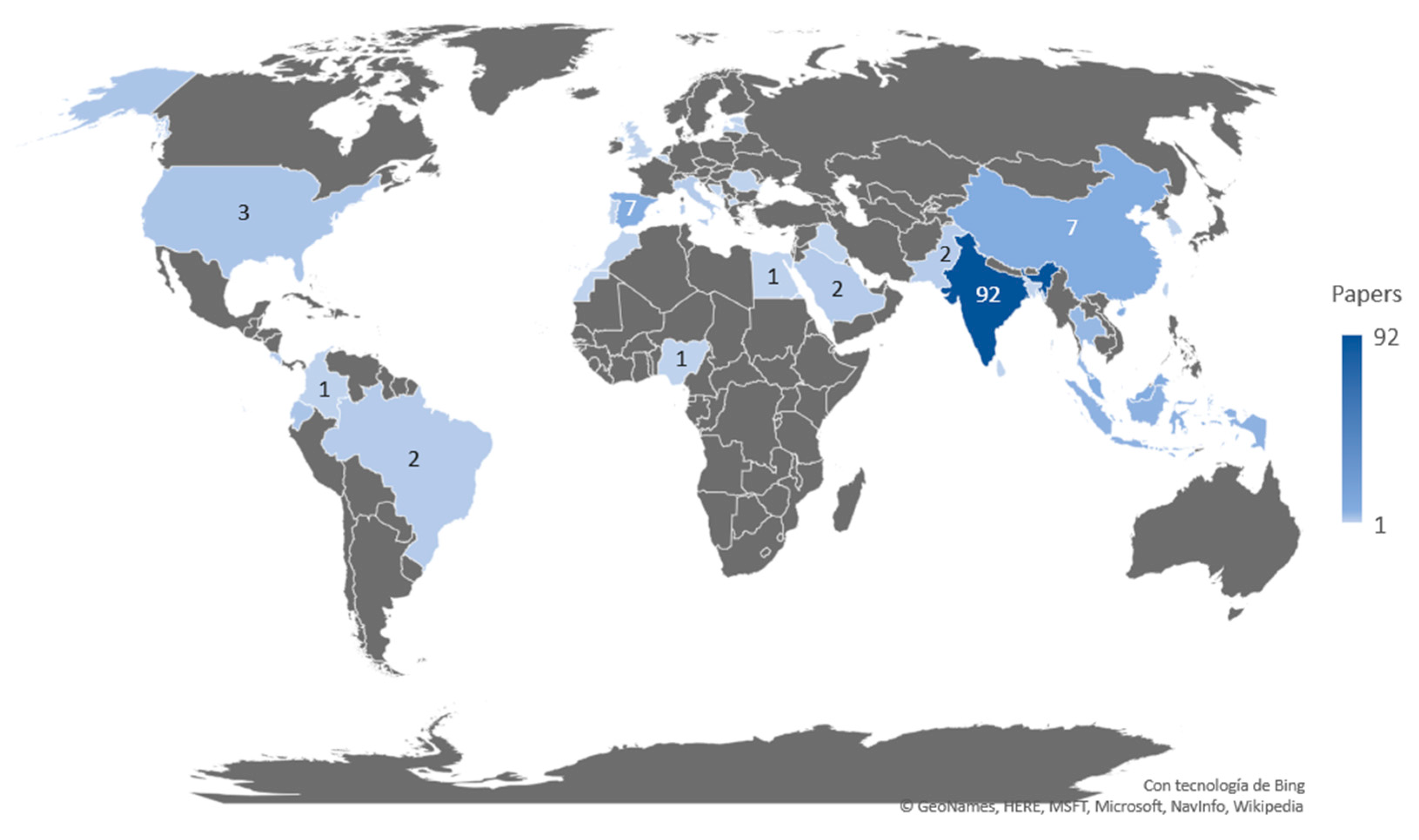
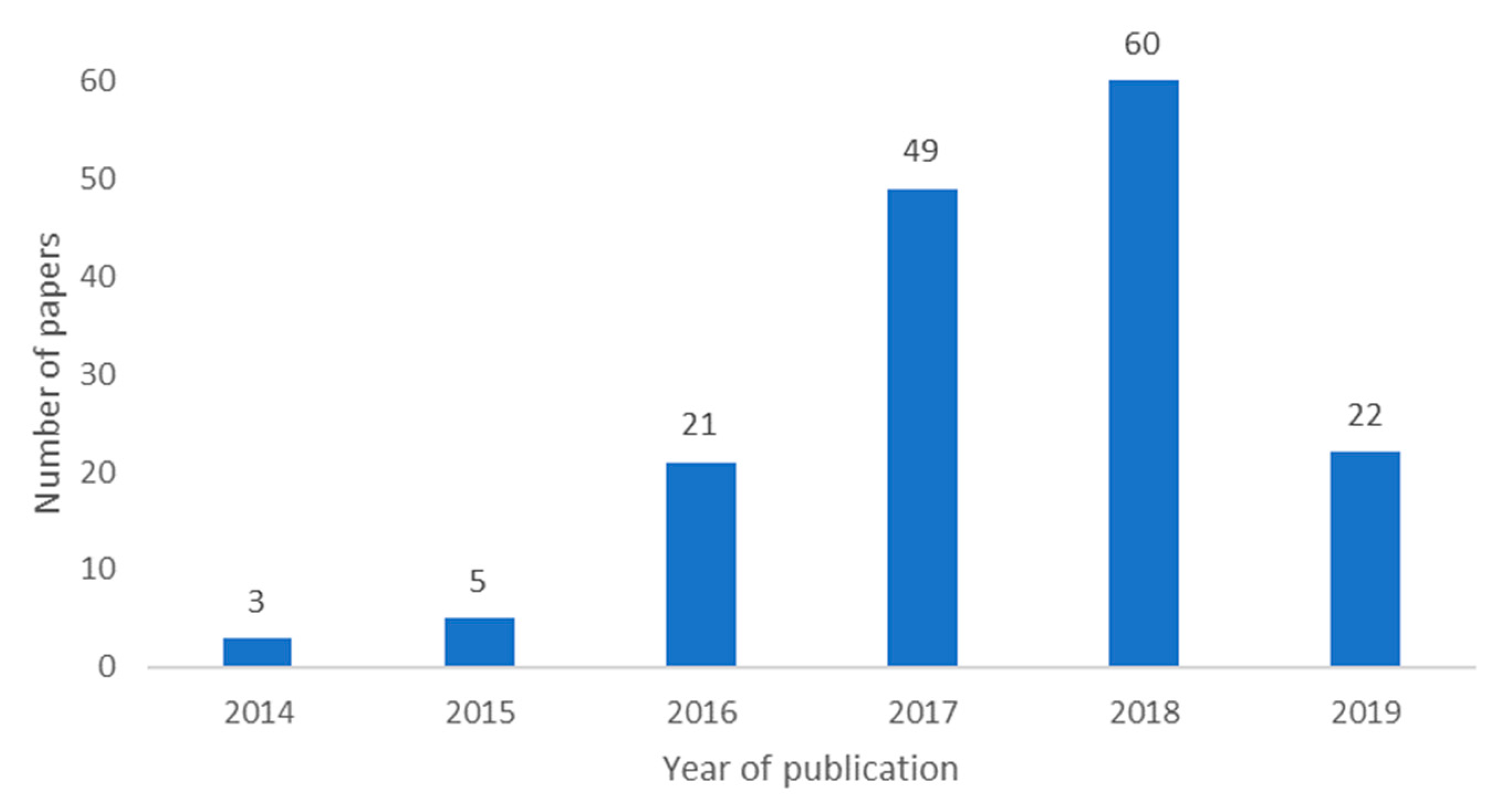
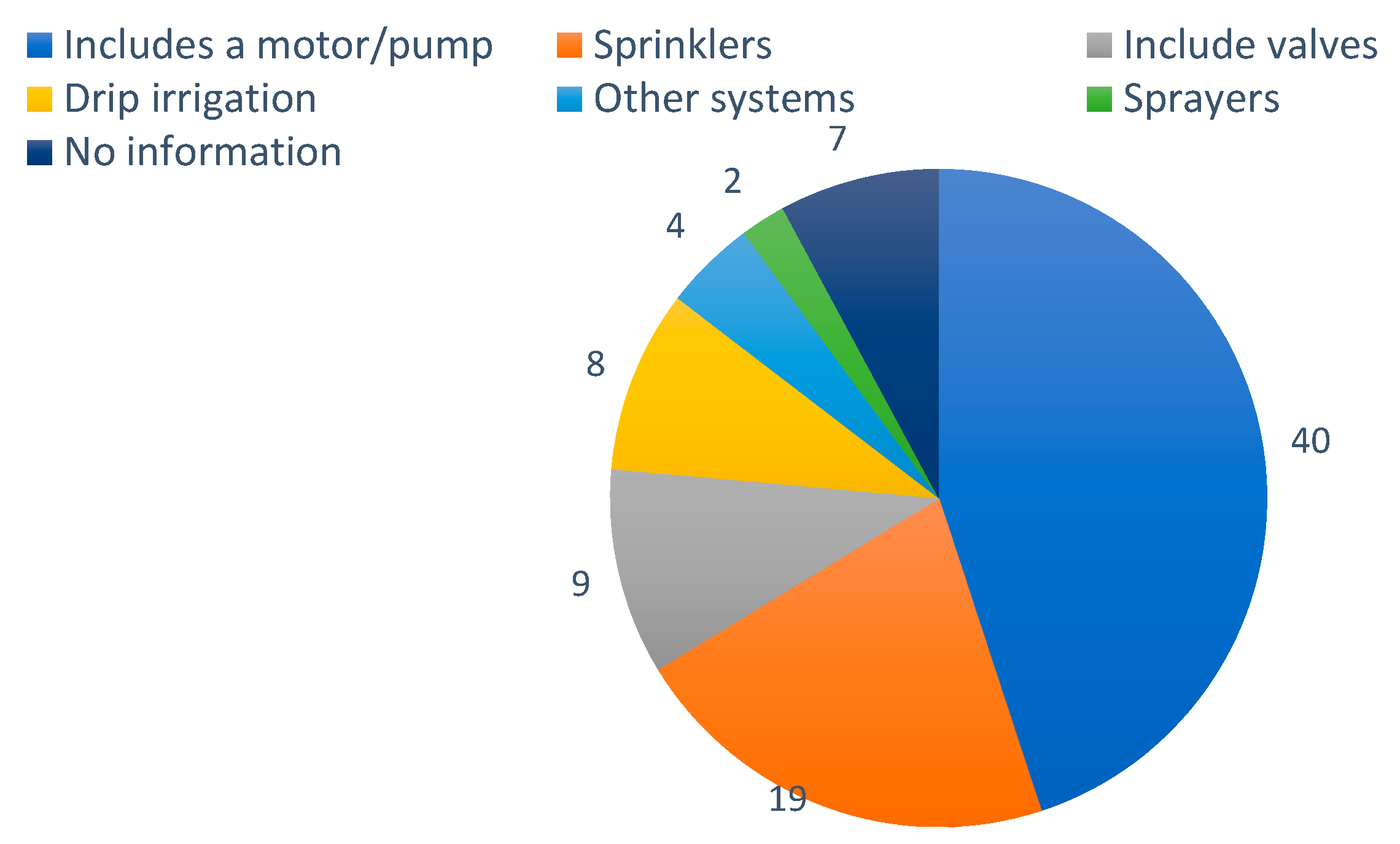

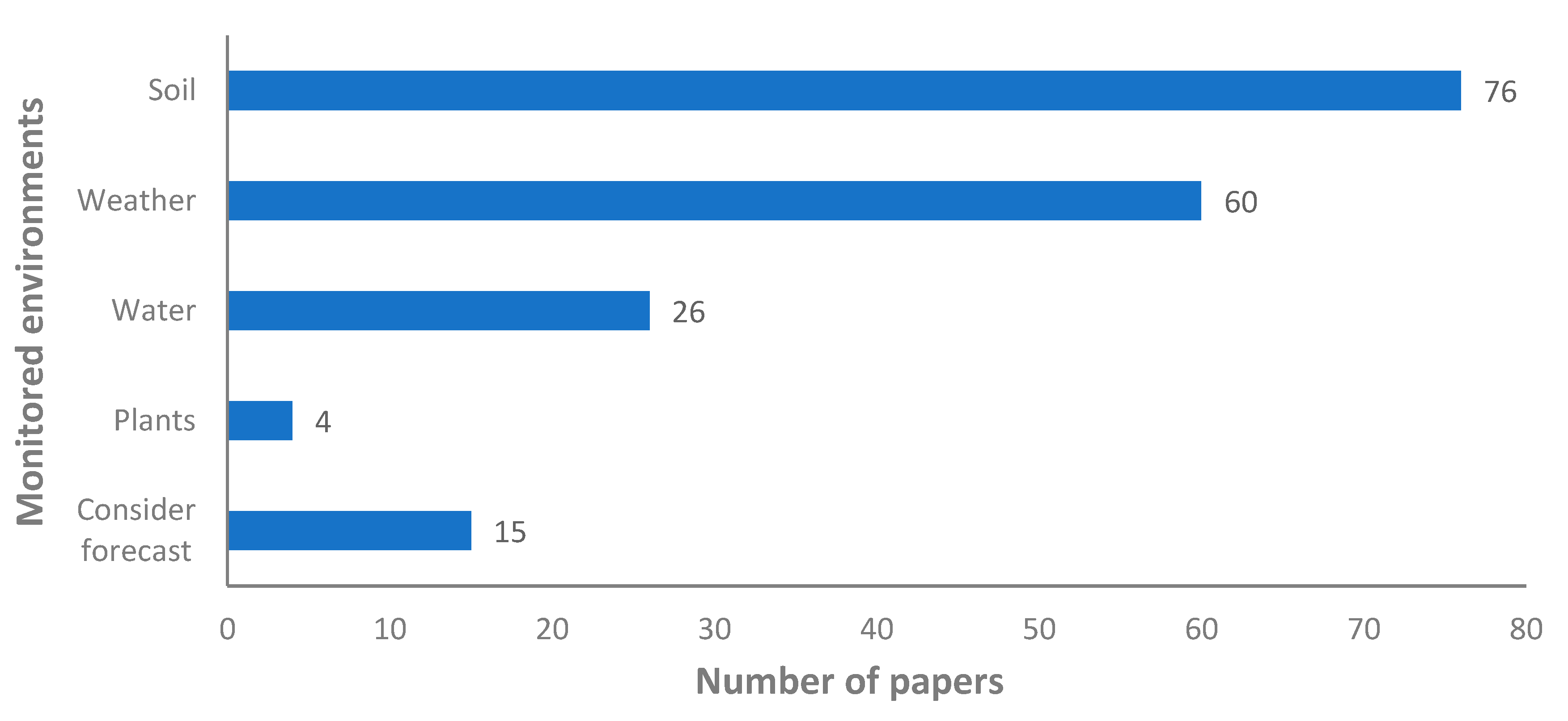

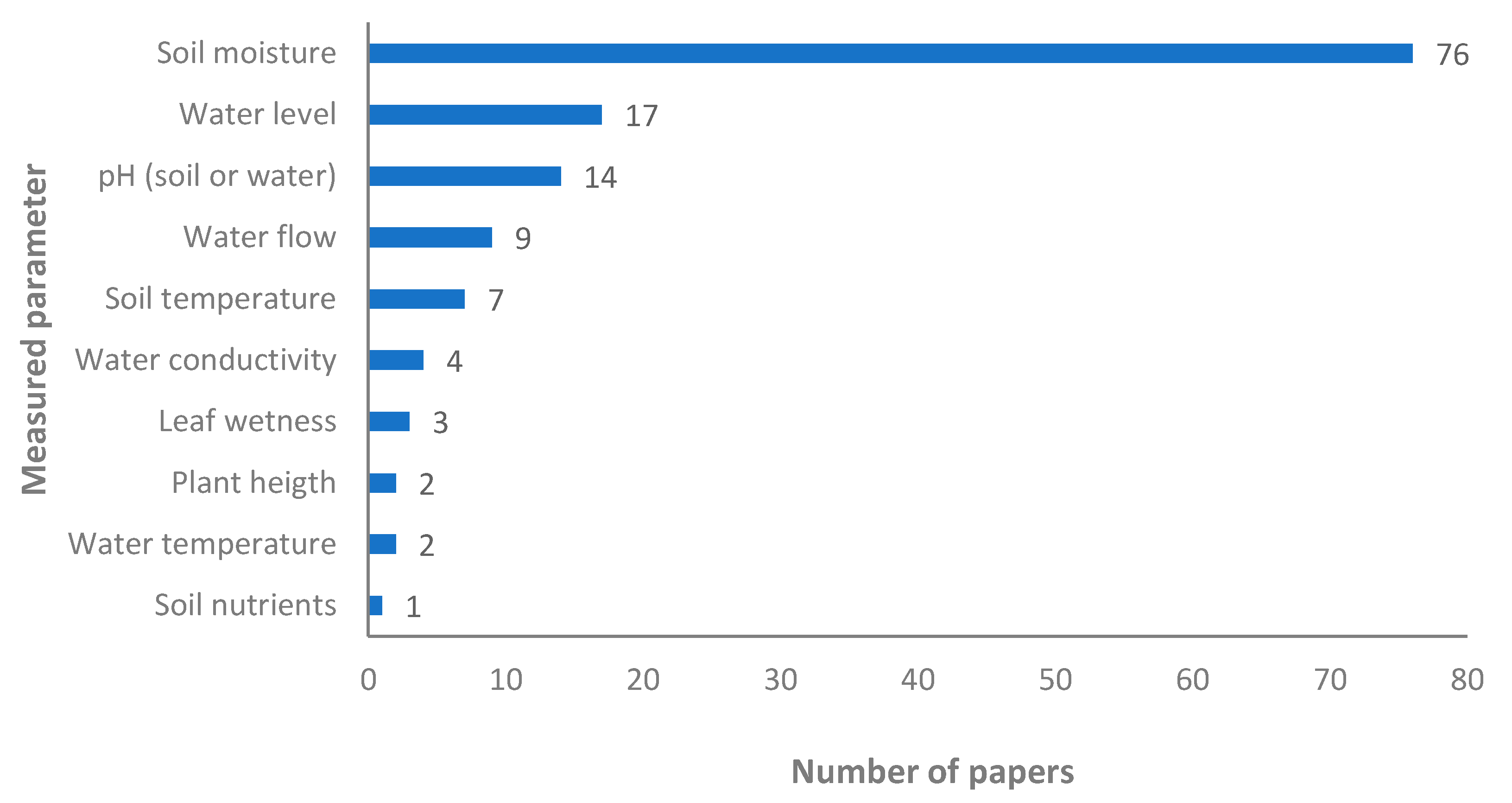
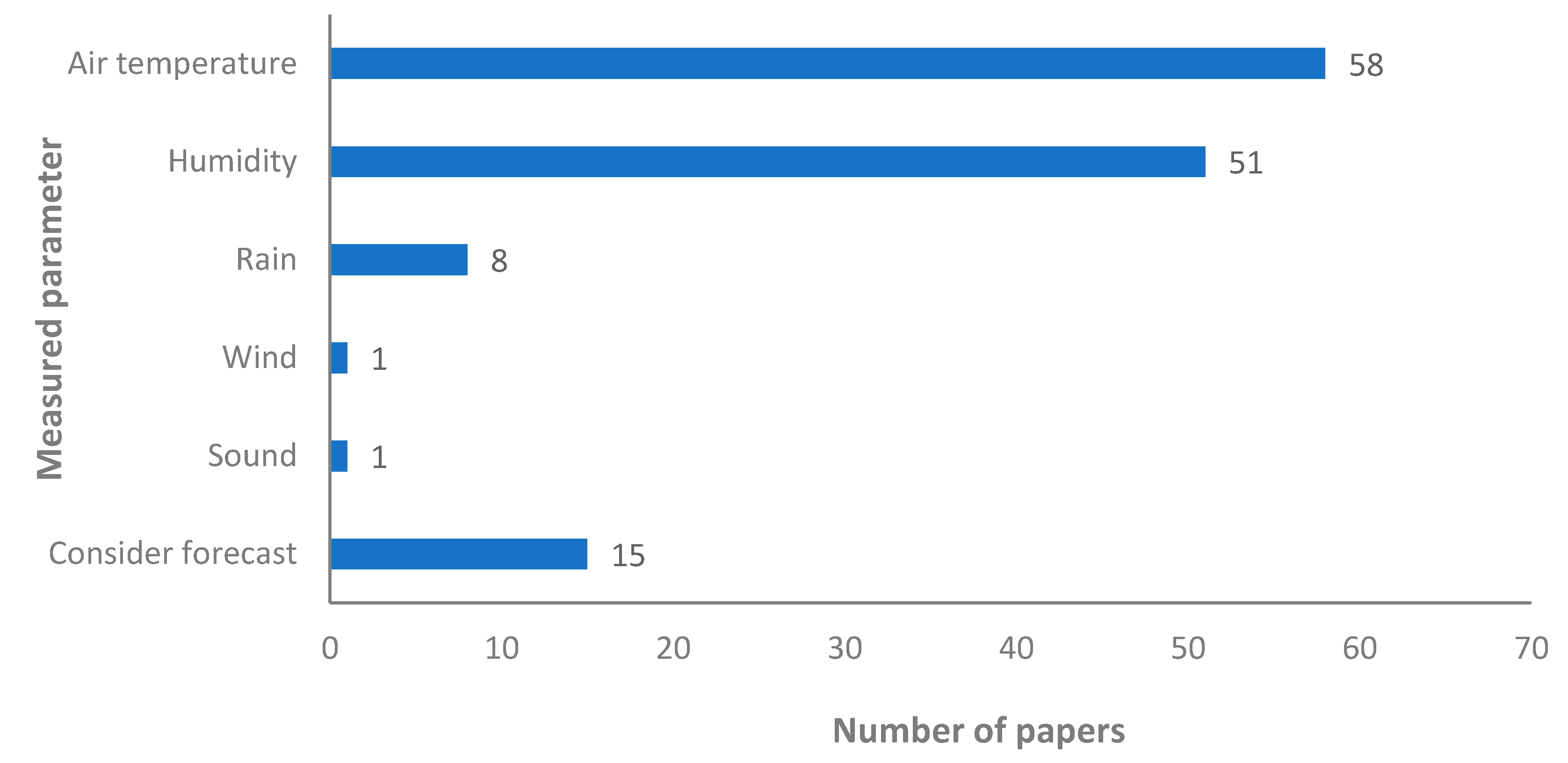
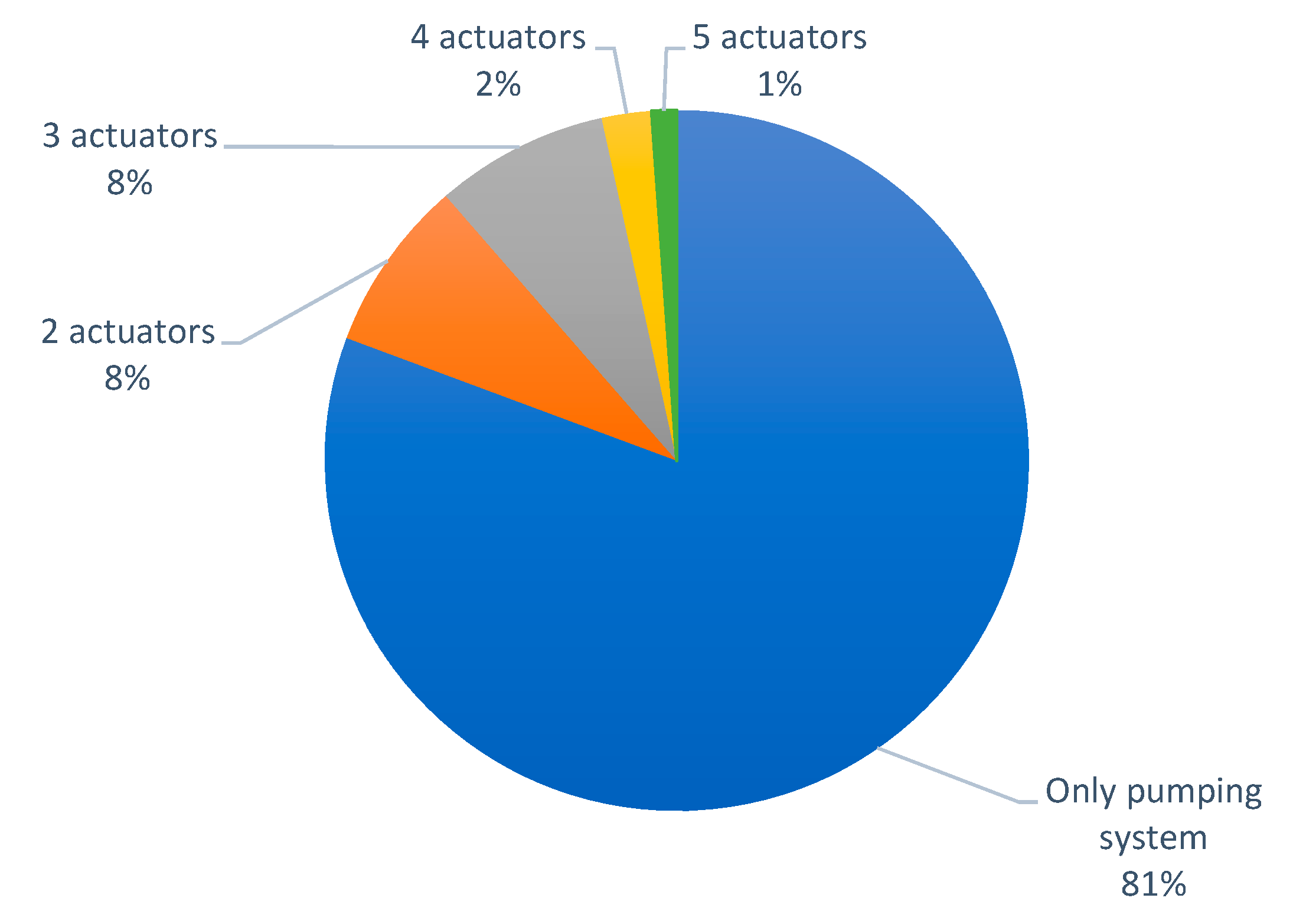
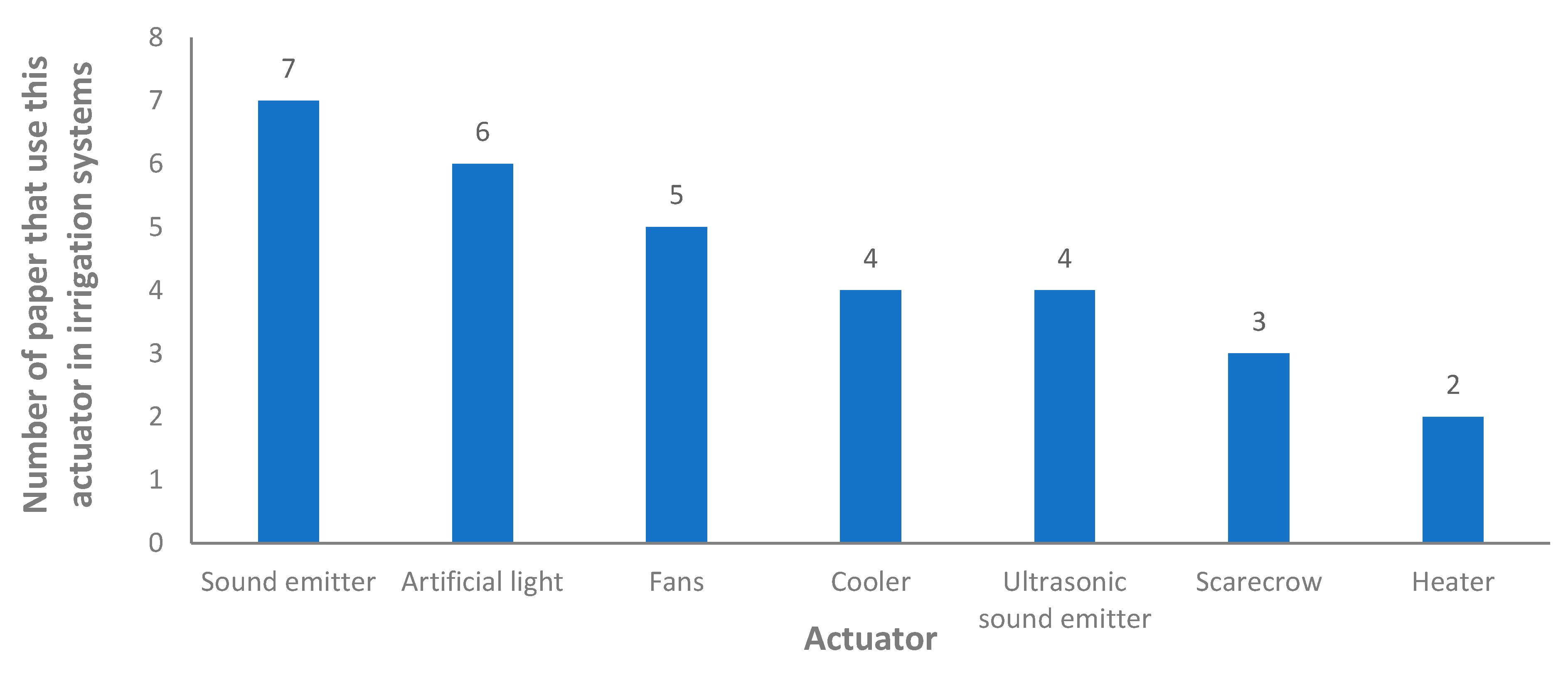

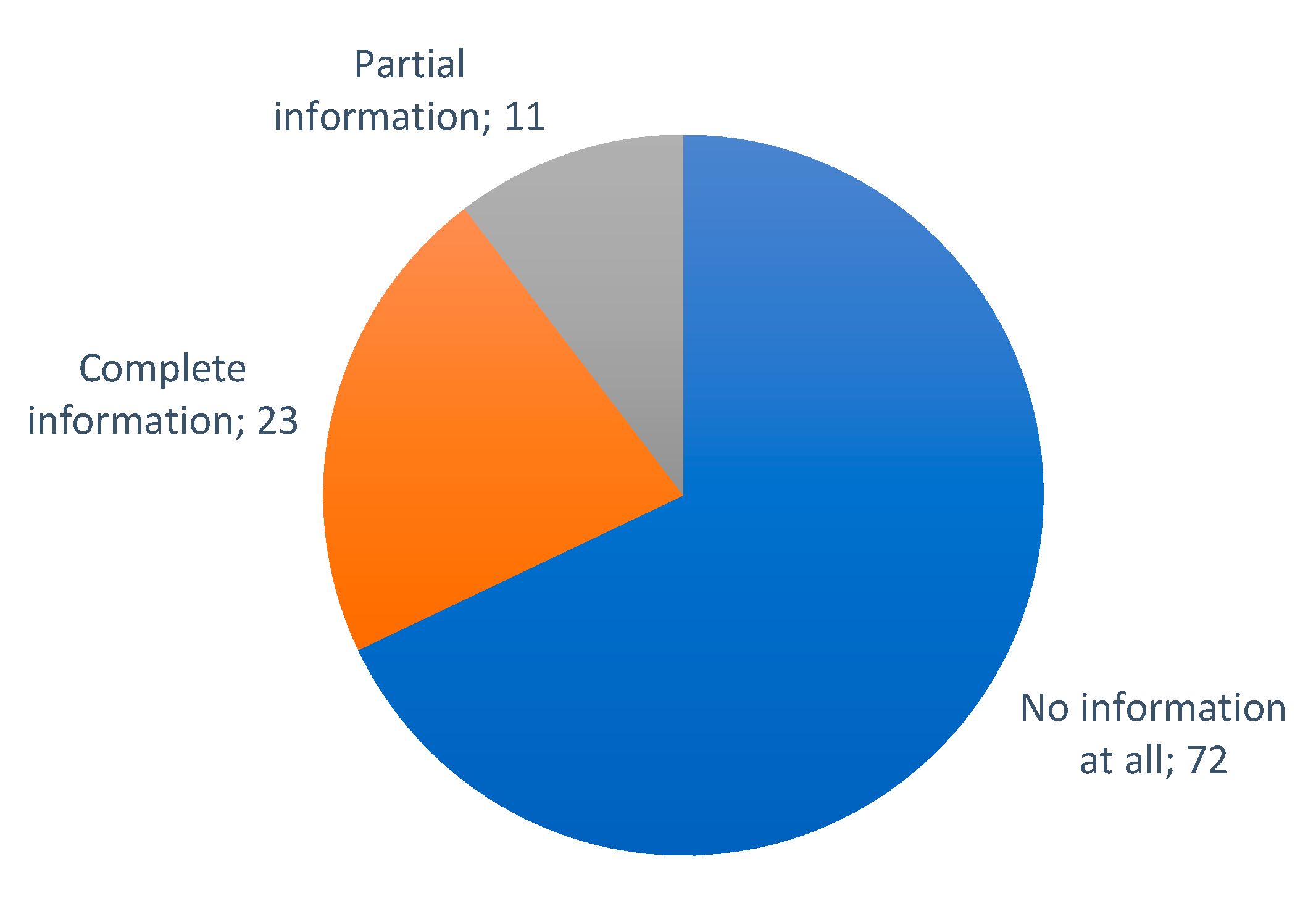

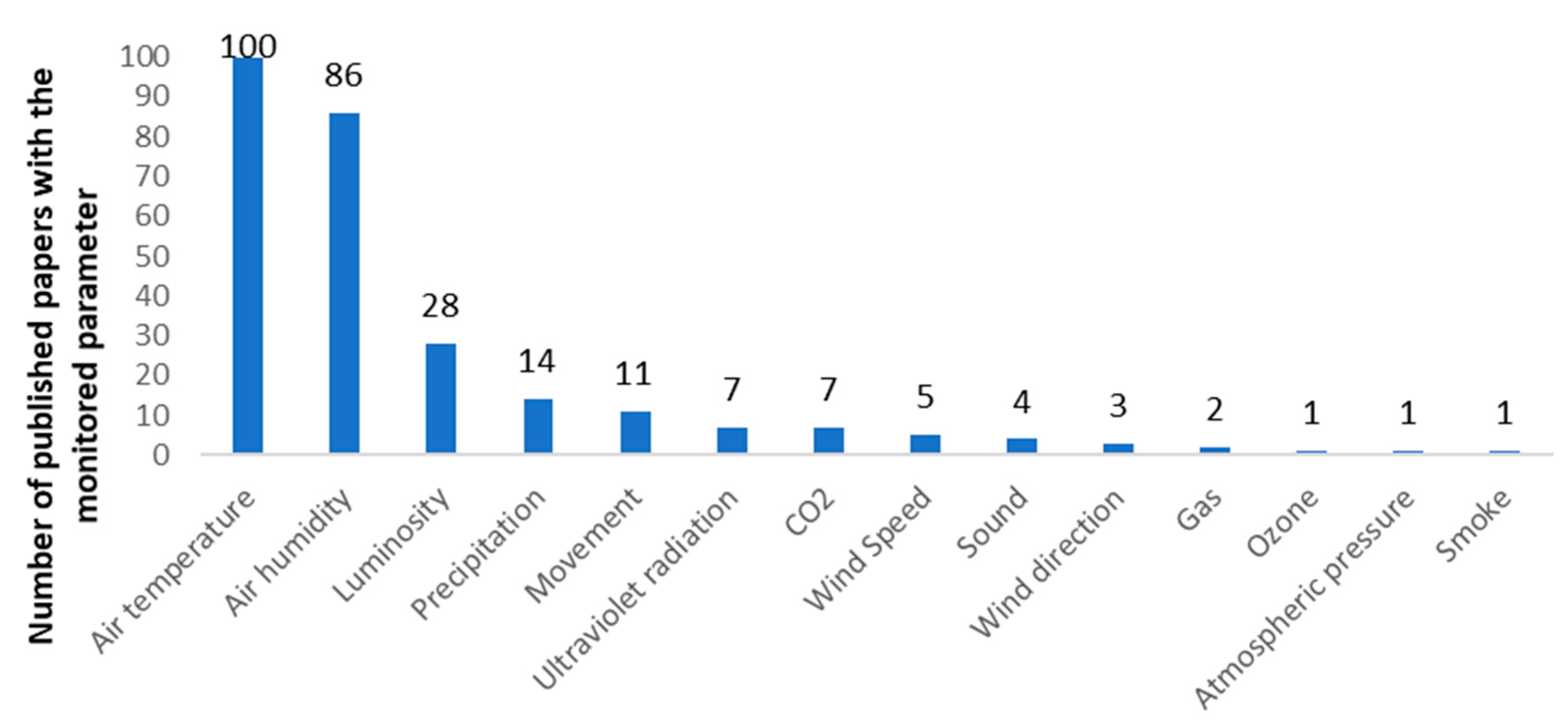

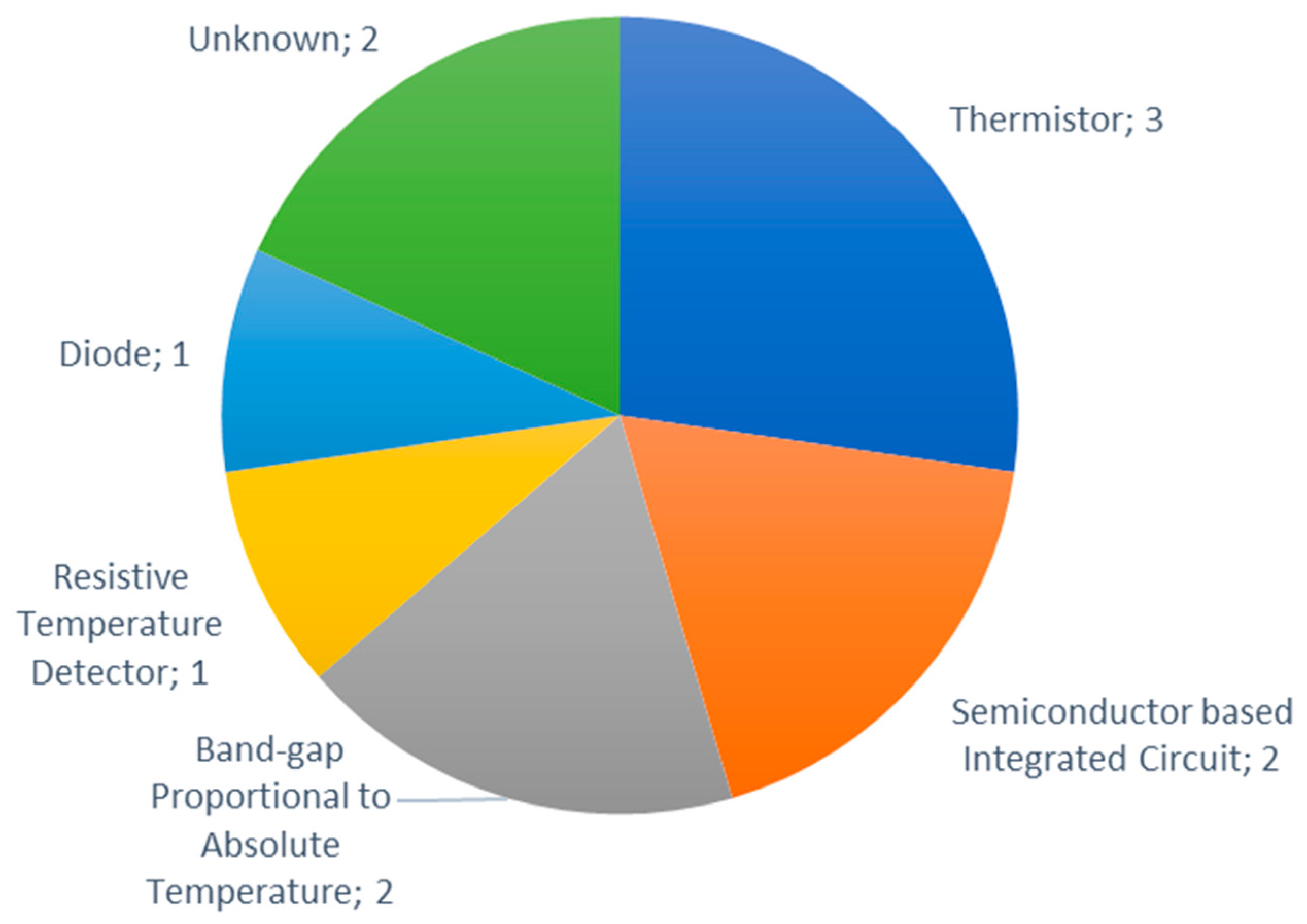
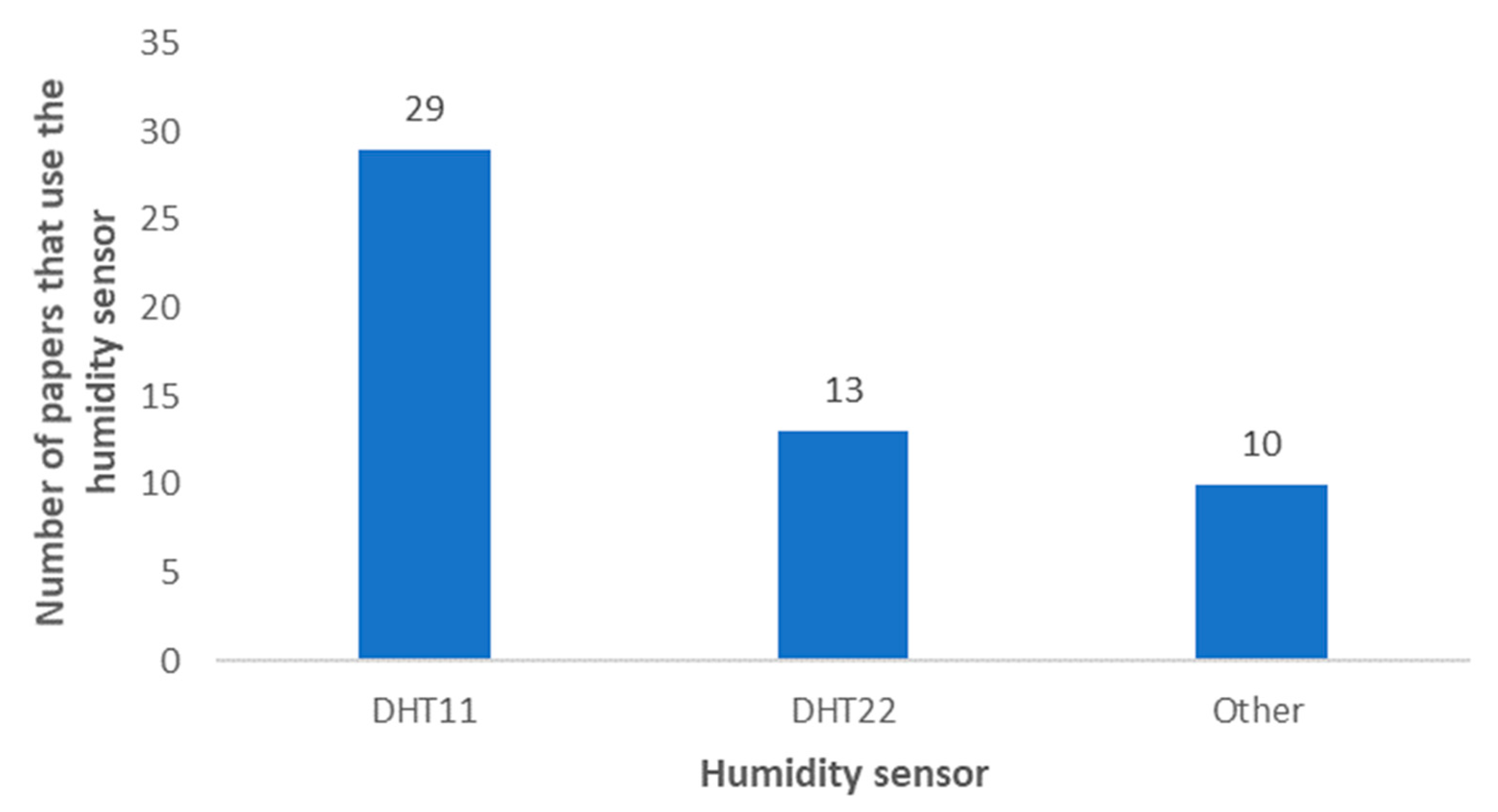


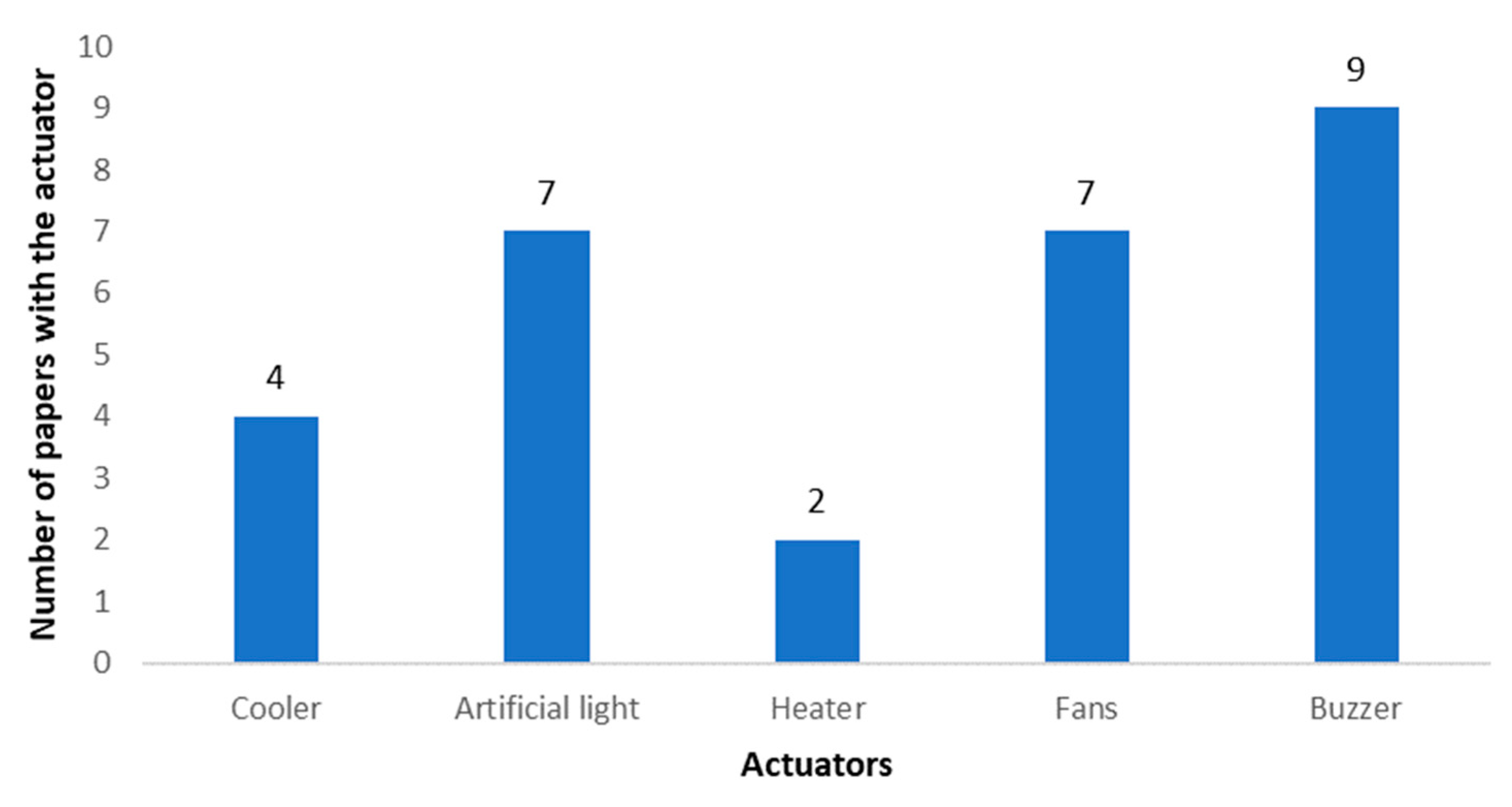

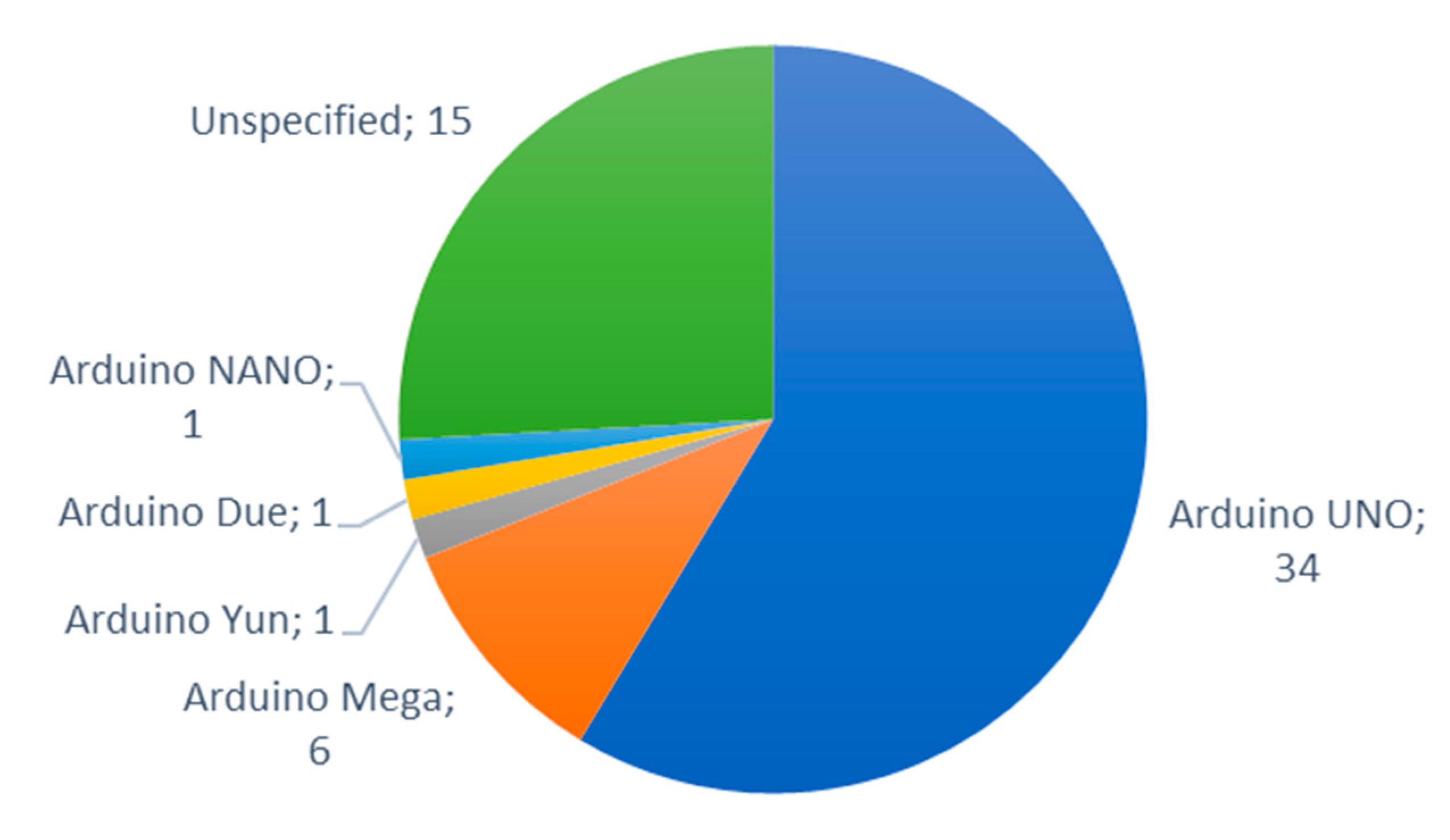



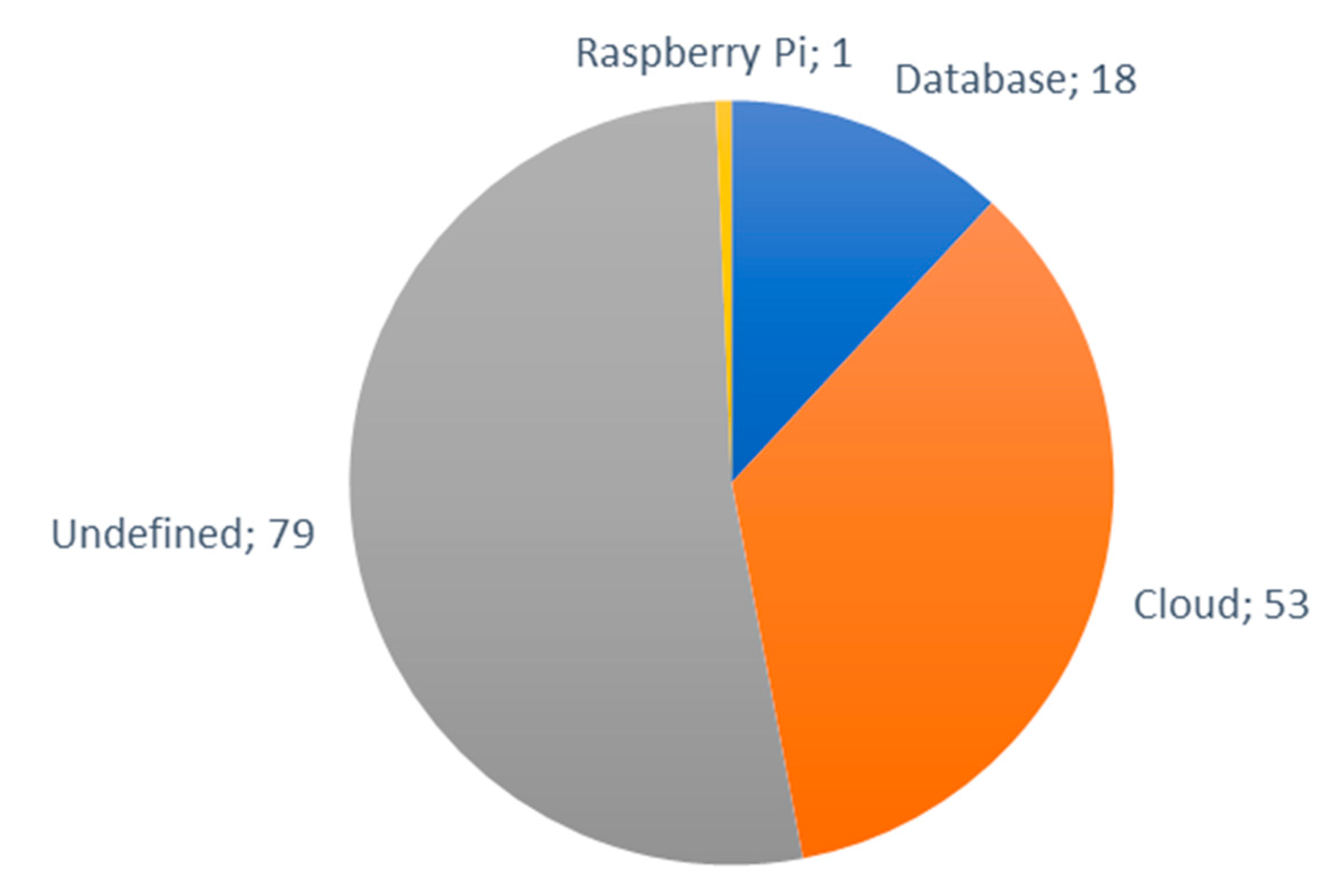
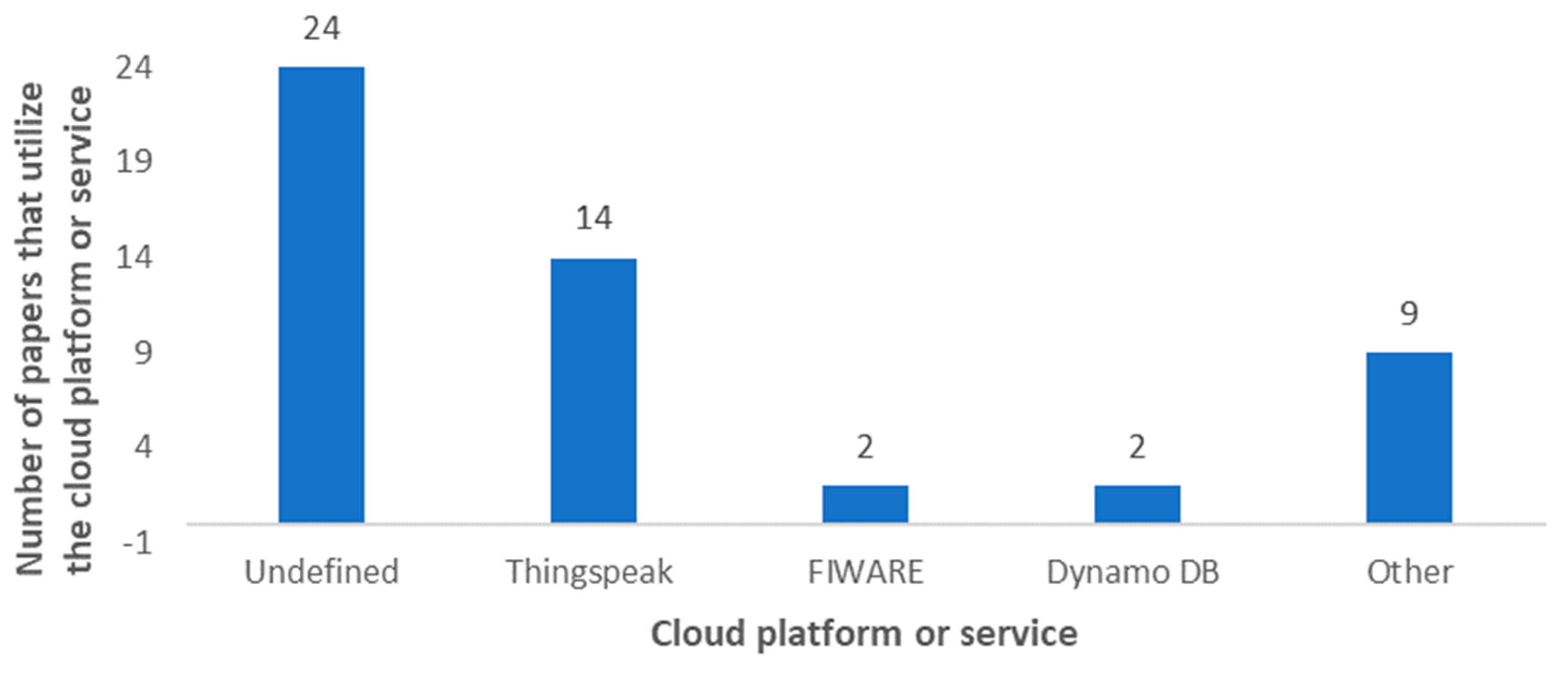



| Parameter | References |
|---|---|
| Air temperature | [28,32,34,35,45,46,47,48,49,50,51,52,56,57,58,59,61,62,63,64,65,66,67,68,71,72,73,74,75,76,80,81,82,83,84,85,86,87,88,89,91,93,94,96,97,98,99,100,102,103,111,114,115,117,118,119,120,121,122,124,125,126,127,128,129,130,131,132,133,134,135,136,137,138,139,140,141,142,143,144,145,146,147,148,149,150,151,152,153,154,155,156,157,158,159,160,161,162] |
| Relative humidity | [14,28,34,35,42,45,46,47,48,49,51,57,58,59,61,62,63,64,65,66,67,68,71,72,73,74,75,76,81,84,85,86,87,88,89,91,93,94,95,96,97,98,99,100,102,103,111,114,115,117,118,119,120,121,122,125,126,127,130,131,133,135,137,138,139,140,142,143,144,145,146,148,150,153,154,155,156,157,158,159,160,162,163,164,165] |
| Precipitation | [30,46,48,50,61,67,76,95,114,119,137,143,157] |
| Luminosity | [28,45,48,62,63,65,66,67,71,72,76,91,99,112,118,119,125,126,129,131,136,140,144,145,154,156,157,159] |
| Sensor | Temperature Range | Accuracy | Reference | |
|---|---|---|---|---|
| Min | Max | |||
| DHT11 | 0 °C | 50 °C | ±2 °C | [28,59,61,62,64,71,87,93,94,101,103,115,117,118,119,121,130,131,135,139,143,144,148,154,159,160,162] |
| DHT22 | −40 °C | 125 °C | ±0.5 °C | [76,88,95,96,114,120,126,144,146,151,155,156,158] |
| LM35 | −55 °C | 150 °C | - | [48,49,53,56,65,80,82,84,91,98,103,129,132,165] |
| Sensor | Humidity Range | Accuracy | Reference | |
|---|---|---|---|---|
| Min | Max | |||
| DHT11 | 20% | 90% | ±5% | [28,59,61,62,64,71,87,93,94,101,103,115,117,118,119,121,130,131,135,139,143,145,148,154,156,159,160] |
| DHT22 | 0% | 100% | ±5% | [76,88,95,96,114,120,126,144,146,151,155,156,158] |
| Node | Reference |
|---|---|
| WEMOS MINI D1 | [71,87,89] |
| Node MCU | [41,43,86,97,113,114,127,153,155,158,167,168,169] |
| Arduino Mega | [52,55,56,72,170,171] |
| Arduino UNO | [34,36,40,44,49,54,55,61,62,64,69,76,84,91,111,112,117,119,121,127,129,139,143,144,151,153,154,156,160,166,168,172,173,174] |
| Raspberry Pi 2 Model B | [66,69,165,175] |
| Raspberry Pi 3 Model B+ | [58,112,176] |
| Intel Galileo Gen-2 | [30,51,77] |
| Group | Technology | Frequency Bands | Max. Data Rate |
|---|---|---|---|
| Cellular | 3G | 380.2–389.8 MHz, 390.2–399.8 MHz, 410.2–419.8 MHz, 420.2–429.8 MHz, 450.6–457.6 MHz, 460.6–467.6 MHz, 479.0–486.0 MHz, 489.0–496.0 MHz, 698.2–716.2 MHz, 728.2–746.2 MHz, 777.2–792.2 MHz, 747.2–762.2 MHz, 806.2–821.2 MHz, 851.2–866.2 MHz, 824.2–848.8 MHz, 869.2–893.8 MHz, 890.0–915.0 MHz, 935.0–960.0 MHz, 880.0–915.0 MHz, 925.0–960.0 MHz, 876.0–915.0 MHz, 921.0–960.0 MHz, 870.4–876.0 MHz, 915.4–921.0 MHz, 1710.2–1784.8 MHz, 1805.2–1879.8 MHz, 1850.2–1909.8 MHz, 1930.2–1989.8 MHz | Upload 7.2 Mbps Download 2 Mbps |
| 4G/LTE | 452.5–457.5 MHz, 462.5–467.5 MHz, 703–748 MHz, 703–803 MHz, 704–716 MHz, 717–728 MHz, 734–746 MHz, 738–758 MHz, 758–803 MHz, 791–821 MHz, 807–824 MHz, 814–849 MHz, 815–830 MHz, 824–849 MHz, 830–845 MHz, 832–862 MHz, 852–869 MHz, 859–894 MHz, 860–875 MHz, 869–894 MHz, 875–890 MHz, 880–915 MHz, 925–960 MHz, 1427.9–1447.9 MHz, 1475.9–1495.9 MHz, 1447–1467 MHz, 1447.9–1462.9 MHz, 1495.9–1510.9 MHz, 1525–1559 MHz, 1626.5–1660.5 MHz, 1710–1770 MHz, 1710–1755 MHz, 1710–1780 MHz, 1710–1785 MHz, 1749.9–1784.9 MHz, 1805–1880 MHz, 1844.9–1879.9 MHz, 1850–1910 MHz, 1850–1915 MHz, 1880–1920 MHz, 1910–1930 MHz, 1930–1990 MHz, 1930–1995 MHz, 1920–1980 MHz, 1920–2010 MHz, 2000–2020 MHz, 2010–2025 MHz, 2110–2155 MHz, 2110–2170 MHz, 2180–2200 MHz, 2300–2400 MHz, 2305–2315 MHz, 2350–2360 MHz, 2496–2690 MHz, 2500–2570 MHz, 2620–2690 MHz, 3400–3600 MHz, 3410–3490 MHz, 3510–3590 MHz, 3600–3800 MHz, 5150–5925 MHz | Upload 150 Mbps Download 50 Mbps | |
| 5G | Frequency Range 1: 663–698 MHz, 617–652 MHz, 699–716 MHz, 703–748 MHz, 717–728 MHz, 729–746 MHz, 758–803 MHz,788–798 MHz, 758–768 MHz, 791–821 MHz, 815–830 MHz, 824–849 MHz, 832–862 MHz, 860–875 MHz, 869–894 MHz, 880–915 MHz, 925–960 MHz, 1427–1432 MHz, 1427–1470 MHz, 1432–1517 MHz, 1475–1518 MHz, 1695–1710 MHz, 1710–1780 MHz, 1710–1785 MHz, 1805–1880 MHz, 1850–1910 MHz, 1850–1915 MHz, 1880–1920 MHz, 1920–1980 MHz, 1920–2010 MHz, 1930–1990 MHz, 1930–1995 MHz,1995–2020 MHz, 2010–2025 MHz, 2110–2170 MHz, 2110–2200 MHz, 2300–2400 MHz, 2305–2315 MHz, 2350–2360 MHz, 2496–2690 MHz, 2500–2570 MHz, 2570–2620 MHz, 2620–2690 MHz, 3300–4200 MHz, 3300–3800 MHz, 3550–3700 MHz, 4400–5000 MHz Frequency Range 2: 26.50–29.50 GHz, 24.25–27.50 GHz, 37.00–40.00 GHz, 27.50–28.35 GHz | ||
| Wireless Personal Area Networks | IEEE 802.15.1—Bluetooth | 2400–2483.5 MHz | Up to 3 Mbps |
| BLE (Bluetooth Low-Energy) | 2.400–2.4835 GHz | Up to 2 Mbps | |
| RFID | Radio Frequency Identification (RFID) | Low Frequency: 125 or 134.2 kHz High Frequency: 13.56 MHz Ultra High Frequency: 868–956 MHz Microwaves: 2.45 | UHF: Up to 640 kbps |
| Mesh Protocols | Zigbee | 868–868.6 MHz, 902–9286 MHz, 2400 MHz | Up to 250 kbps |
| Z-Wave | 865.2 MHz, 869 MHz, 868.4 MHz, 868.40 MHz, 868.42 MHz, 869.85 MHz, 908.4 MHz, 908.42 MHz, 916 MHz, 919.8 MHz, 921.4 MHz, 919–923 MHz, 920–923 MHz, 920–925 MHz, 922–926 MHz | Up to 100 kbps | |
| Thread | Global: 2400–2500 MHz America, Australia: 902–928 MHz Europe: 868–868.6 MHz, | Up to 250 kbps | |
| WiFi | IEEE 802.11a | 5725–5875 MHz | Up to 54 Mbps |
| IEEE 802.11b | 2400–2500 MHz | Up to 11 Mbps | |
| IEEE 802.11g | 2400–2500 MHz | Up to 54 Mbps | |
| IEEE 802.11n | 2400–2500 MHz, 5725–5875 MHz | Up to 600 Mbps | |
| IEEE 802.1ac | 2400–2500 MHz, 5725–5875 MHz | Up to 3.46 Gbps | |
| IEEE 802.11ah | AH All Countries: 2400–2500 MHz, 5725–5875 MHz AH Europe: 863–868 MHz AH USA: 902–928 MHz AH China:755–787 MHz AH Japan: 916.5–927.5 MHz AH Korea: 917.5–923.5 MHz AH Singapore: 866–869 MHz, 920–925 MHz | Up to 40 Mbps | |
| Low-Power Wide Area Network (LPWAN) | NarrowBand IoT (NB-IoT) | Global: 1950 MHz, 2140 MHz, 1747.5 MHz, 1842.5 MHz, 897.5 MHz, 942.5 MHz, 455 MHz, 465 MHz | 200 kbps |
| EMEA: 847 MHz, 806 MHz, 453.5 MHz, 463.5 MHz | |||
| EU: 725.5 MHz, 780.5 MHz | |||
| North America Region: 1880 MHz, 1960 MHz, 1732.5 MHz, 2132.5 MHz, 836.5 MHz, 881.5 MHz, 707.5 MHz, 737.5 MHz, 782 MHz, 751 MHz, 793 MHz, 763 MHz, 710 MHz, 740 MHz, 1882.5 MHz, 1962.5 MHz, 831.5 MHz, 876.5 MHz, 1745 MHz, 2155 MHz, 1702.5 MHz, 2007.5 MHz, 680.5 MHz, 634.5 MHz, 1448.5 MHz, 1496.5 MHz, 707 MHz, 737 MHz | |||
| APAC: 725.5 MHz, 780.5 MHz, 452.5 MHz, 462.5 MHz | |||
| Japan: 1437.9 MHz, 1485.9 MHz, 822.5 MHz, 867.5 MHz, 837.5 MHz, 882.5 MHz, 1455.4 MHz, 1503.4 MHz | |||
| Long Term Evolution—Machine Type Communication (LTE-M) | Global: 1950 MHz, 2140 MHz, 1747.5 MHz, 1842.5 MHz, 897.5 MHz, 942.5 MHz, 455 MHz, 465 MHz | Upload peak rate of 5 Mbps Download peak rate of 10 Mbps | |
| EMEA: 2535 MHz, 2655 MHz, 847 MHz, 806 MHz, 453.5 MHz, 463.5 MHz | |||
| EU: 725.5 MHz, 780.5 MHz | |||
| North America Region: 1880 MHz, 1960 MHz, 1732.5 MHz, 2132.5 MHz, 836.5 MHz, 881.5 MHz, 707.5 MHz, 737.5 MHz, 782 MHz, 751 MHz, 793 MHz, 763 MHz, 1882.5 MHz, 1962.5 MHz, 831.5 MHz, 876.5 MHz, 815.5 MHz, 860.5 MHz, 1745 MHz, 2155 MHz, 680.5 MHz, 634.5 MHz, 1448.5 MHz, 1496.5 MHz, 707 MHz, 737 MHz | |||
| APAC: 452.5 MHz, 462.5 MHz, 725.5 MHz, 780.5 MHz | |||
| China: TDD, 1900 MHz, TDD, 2350 MHz | |||
| Japan: 1437.9 MHz, 1485.9 MHz, 822.5 MHz, 867.5 MHz, 837.5 MHz, 882.5 MHz, 1455.4 MHz, 1503.4 MHz | |||
| Extended coverage GSM (EC-GSM) | Global: 385 MHz, 395 MHz, 415 MHz, 425 MHz, 454 MHz, 464 MHz, 482.4 MHz, 492,4 MHz, 707.2 MHz, 737.2 MHz, 785.2 MHz, 755.2 MHz, 813.7 MHz, 858.7 MHz | Downlink Peak Data Rate: 70 kbps (GSMK), 240 kbps (8PSK) Uplink Peak Data Rate: 70 kbps (GSMK), 240 kbps (8PSK) | |
| APAC & EMEA: 897 MHz, 942 MHz | |||
| Caribbean, LATAM & North America Region: 836.5 MHz, 881.5 MHz, 1880 MHz, 1960 MHz | |||
| ITU Region 1 & 3: 902.5, 947.5 MHz, 895.5 MHz, 940.5 MHz, 1747.5 MHz, 1842.5 MHz | |||
| Sigfox | RC1: 868.130 MHz, 869.525 MHz RC2: 902.200 MHz, 905.200 MHz RC3: 923.200 MHz, 922.200 MHz RC4: 920.800 MHz, 922.300 MHz RC5: 923.300 MHz, 922.300 MHz RC6: 865.200 MHz, 866.200 MHz | 100 or 600 bps | |
| LoRa—Low Power Wide Area Network (LoRaWAN) | Europe: 870 MHz, 863 MHz, 434 MHz, 433 MHz India: 867 MHz, 865 MHz Region 2—America, Greenland, Eastern Pacific Islands: 928 MHz, 902 MHz Australia, New Zealand: 928 MHz, 915 MHz China: 510 MHz, 470 MHz, 787 MHz, 779 MHz Hong Kong: 925 MHz, 920 MHz Taiwan: 928 MHz, 922 MHz South Korea: 923 MHz, 920 MHz Japan: 928 MHz, 920 MHz Singapore, Thailand, Vietnam: 925 MHz, 920 MHz Brunei, Cambodia, Indonesia, Laos: 925 MHz, 923 MHz | 0.3 to 50 kbps | |
| MIOTY | 868 MHz |
| Technology | References |
|---|---|
| Ethernet | [52,62,72,99,117,131,138,139,146,152,164] |
| GSM | [35,36,44,48,51,57,61,64,72,73,79,85,90,91,92,103,112,129,153,157,185,186,187,188,189] |
| Wi-Fi | [28,34,41,43,46,47,50,51,52,53,56,59,60,64,65,66,69,70,71,77,82,84,88,94,95,111,112,116,117,119,120,123,125,126,127,128,129,132,134,135,139,143,151,152,153,154,156,157,158,160,163,165,166,168,169,173,182,187,190,191,192,193,194] |
| ZigBee | [5,32,39,42,63,65,66,67,93,119,120,121,122,123,128,133,137,144,151,157,175,185,191] |
| Bluetooth | [46,53,81,118,129,132,134,156,174,181,195,196] |
| LoRa | [14,31,78,95,142,144,145,149,157,196,197] |
| GPRS | [44,45,67,73,79,98,101,122,137,157,161,171,179,186,190] |
| MQTT | [47,75,86,113,114,160,175,176] |
| 4G | [14,45,78,138,141,145,152] |
| 6LoWPAN | [75,147] |
| IEEE 802.15.4 | [73,102] |
© 2020 by the authors. Licensee MDPI, Basel, Switzerland. This article is an open access article distributed under the terms and conditions of the Creative Commons Attribution (CC BY) license (http://creativecommons.org/licenses/by/4.0/).
Share and Cite
García, L.; Parra, L.; Jimenez, J.M.; Lloret, J.; Lorenz, P. IoT-Based Smart Irrigation Systems: An Overview on the Recent Trends on Sensors and IoT Systems for Irrigation in Precision Agriculture. Sensors 2020, 20, 1042. https://doi.org/10.3390/s20041042
García L, Parra L, Jimenez JM, Lloret J, Lorenz P. IoT-Based Smart Irrigation Systems: An Overview on the Recent Trends on Sensors and IoT Systems for Irrigation in Precision Agriculture. Sensors. 2020; 20(4):1042. https://doi.org/10.3390/s20041042
Chicago/Turabian StyleGarcía, Laura, Lorena Parra, Jose M. Jimenez, Jaime Lloret, and Pascal Lorenz. 2020. "IoT-Based Smart Irrigation Systems: An Overview on the Recent Trends on Sensors and IoT Systems for Irrigation in Precision Agriculture" Sensors 20, no. 4: 1042. https://doi.org/10.3390/s20041042
APA StyleGarcía, L., Parra, L., Jimenez, J. M., Lloret, J., & Lorenz, P. (2020). IoT-Based Smart Irrigation Systems: An Overview on the Recent Trends on Sensors and IoT Systems for Irrigation in Precision Agriculture. Sensors, 20(4), 1042. https://doi.org/10.3390/s20041042









